Blade Runner is one of the most evocative proper nouns of our time. Simply mentioning the 1982 classic film is enough to give fans goosebumps.
Despite its cult status, Blade Runner is an underappreciated marvel. The genre-defining adaptation of Do Androids Dream of Electric Sheep from author Philip K. Dick was ahead of its time, sadly to its box office detriment.
Luckily for fans, new and old, we can consistently appreciate director Ridley Scott’s revolutionary masterpiece.
Whether you’re a stickler for correctly referencing the seven versions of the 1982 classic or simply love the films, the Blade Runner franchise’s contribution to modern media is invaluable.

Like the original, Denis Villeneuve’s Blade Runner 2049 wasn’t much of a commercial success. Despite a positive critics' consensus, the modern sequel failed to earn over $100 million.
Poor profit margins aside, we’ve had a few good years to admire and unpack Villeneuve’s 2017 masterpiece.
Jumpstart your ideas with Linearity Curve
Take your designs to the next level.
Considering the two Blade Runners and their hyper-loaded visual directions and aesthetics, we thought it was time to write a detailed love letter to the franchise’s cybernetic eye candy.
It’s difficult to fully appreciate Blade Runner and Blade Runner 2049’s combined impact on media, fashion, and graphic design. Still, we went as deep as possible (even if we’re only human).
We’ll be exploring both films’ mind-boggling color palettes, cinematography, and setting constructions.

First, let’s answer our original question, what is a Blade Runner?
An overview of the Blade Runners
A “Blade Runner” is a futuristic bounty hunter tasked with violently decommissioning “replicants,” androids that have broken free of their human masters’ control. These uncanny products of genetic engineering were made to serve, understandably yearning for more than just hard labor.

Replicants don’t fire rockets from their wrists or pump acid blood through their veins. They’re human in appearance and behavior, save for their super-strength and a few plot-central psychological details.
The po-faced replicants rarely show emotion, but their eyes occasionally glow gold or red, giving them a supernatural edge, especially when subjected to the Voight-Kampff Test.
These complex androids are key to the Blade Runner world, developing in intriguing ways alongside it.
A cyberpunk revamp 35 years in the making
We’d never try to establish which Blade Runner film is better, but given how unique each is, we thought we’d show their connections.
Blade Runner built much of what we consider to be the cyberpunk aesthetic. Gigantic, holographic adverts hanging off dilapidated skyscrapers that loom over neon-drenched and overcrowded streets.

Scott and co. took much inspiration from Hong Kong’s dense and often smoggy architecture, the dark and surreal artist Mœbius, and the iconic German expressionist sci-fi film, Metropolis, from 1927.
By the late 2010s, the cyberpunk look and feel were starting to feel a little bit, dare we say it, familiar. Blade Runner 2049 wasn’t just set to continue the replicant story. It would shake up the cyberpunk aesthetic we know and love.
Do androids dream of electric sequels?
There was a long-held fan theory that Blade Runner would never get a sequel. It was considered too philosophically and technically complex for any second chapter to do it justice.
Beyond fan doubts, sticky licensing issues objectively halted “Blade Runner II” from being green-lit.

During the late 2010s, Blade Runner’s producer Bud Yorkin sold its rights to Alcon Entertainment. The hunt for the ideal director finally began, and several directors were approached, including Scott himself.
As much as Scott would have loved to direct Blade Runner 2049, he had to turn the role down as he was already committed to another sequel, Alien: Covenant. According to Scott, “We wanted to get this [Blade Runner sequel] made... If you get it on paper, don’t wait. I had to let it go, which was a bit of a bugger but there we are.”
Denis Villeneuve was eventually chosen to begin production on the hotly-anticipated sequel, along with Scott Free Productions. The Arrival director had proven himself more than capable of carrying Scott’s torch, much to fans’ excitement.
Scott might have had his hands tied regarding the director role, but that doesn’t mean he wasn’t closely involved with Blade Runner 2049’s development, much to Villeneuve’s stress. As we’ll learn later in this piece, Scott is a bit of a control freak. Villeneuve had to eventually politely but clearly ask his predecessor to give him some room to breathe.
Sadly, the hype wouldn’t bear much fruit at the box office, and Villeneuve’s highly praised but unprofitable Blade Runner 2049 flopped.
In our opinion, profitability is secondary to developing a much-loved universe and its characters.
Looking for more cool drawing ideas?
Check out our list of 25 easy tutorials.
One setting, decades apart
Let’s take a closer look at the progression in the Blade Runner franchise.
Both Blade Runner and Blade Runner 2049 are set in the same world; that much is a given. But what changed in the sequel from the original film’s 2019 setting?
As you might imagine, things got worse (way worse) since the first story. Thirty years is enough time for any dystopia to intensify, and Blade Runner 2049 set a new standard for bleakness.
It’s difficult to imagine a world more desperate than the original Blade Runner, but society is truly on the verge of collapse in 2049.
Technology is grinding to a halt as the Los Angeles setting of both films has been plunged into shadow. Nature’s breaths are limited, and desertification is commonplace.

It all sounds a bit depressing, but that’s cyberpunk for you. Beyond its objective coolness, cyberpunk is meant to inspire a good, hard look at the unsustainable direction humanity is taking the world.
Director Villeneuve and British cinematographer Roger Deakins were faithful to Scott’s original vision while maturing it with their own flair and style. Modern sequels to legendary classics have a phenomenal way of removing any previous technical barriers.
Deakins didn’t hold anything back with Blade Runner 2049, and its crew more than deserved their Best Special Visual Effects and Best Cinematography Academy Awards. But more on cyberpunk cinematography later!
Why Blade Runner will always matter
Blade Runner wasn’t a typical sci-fi blockbuster for its time. Other dystopian films like The Terminator hadn’t been released yet, and most people’s idea of sci-fi films revolved around space operas and funny-looking aliens.
Director Ridley Scott was accused of favoring visuals to a fault with Blade Runner. As designers, we have little to criticize Scott for, as he provided us with an invaluable wealth of inspiration, technique, and reference.
You’ll find Blade Runner inspiration in sci-fi blockbusters like The Matrix, classic anime like Ghost in the Shell, and modern video games like Cyberpunk 2077.
Achieving this perfectionism was rather painful, as you can imagine.
A dystopian production
It’s ironic that Blade Runner sympathizes with artificial intelligence and androids, given its director’s machine-like dedication to perfecting each shot.
Ridley Scott’s background before Blade Runner was in directing zany UK commercials. He was in complete control then and could tweak every little detail to his creative heart’s content.
The power balance was supposed to be a bit different on Blade Runner’s set, but the British stickler took the reins (and the camera) from his American crew.
A production nightmare ensued. Scott continuously micromanaged set designs, camerawork, and lighting, causing numerous delays and reshoots.
Screenwriter David Webb Peoples reworked scenes only to find Scott didn’t need the edits upon submission. The added choking smoke used for special effects and demanding night shoots took a toll on the crew and actors.
It wasn’t surprising to learn Scott was axed moments after production wrapped up, only to be instantly reemployed to hack together new versions of the cinema release.
Lead actor Harrison Ford only found the strength to discuss his experience of Blade Runner’s apparently torturous production years later.

The on-set stress wasn’t the only kind of chaos that fed Blade Runner’s creation.
Worldly fears with an imaginative setting
This is an almost relatable piece of speculative fiction about earthly humans and believable machines. Blade Runner was released during the Cold War’s peak when many feared nuclear devastation and impending doom by unregulated technology.
Ridley Scott’s neo-noir epic follows detective Rick Deckard (played by Harrison Ford) as he plumbs the depths of a dark futuristic world hunting renegade replicants. Harrison Ford’s no-nonsense performance was the direct antithesis of Mark Hamil’s bubbly and energetic portrayal of Luke Skywalker.

Scott’s original film takes the viewer through a mostly nocturnal journey set in a society failed by corporations. Almost every scene is draped in shadows divided by intense beams of light, bringing Philip K. Dick’s low vision of the future to life with the neo-noir style.
Rain is another heavily used element in Blade Runner, cleverly employed for the most emotional responses possible.
Do you see where we’re going with this? Blade Runner was edgy, emotive, and cerebral - the ideal recipe for a cult film.
Scott and his crew brought pioneering technical and artistic ingenuity to their set, changing how Hollywood made sci-fi films. According to Scott, “every incident, every sound, every movement, every color, every set, prop or action has significance within the performance of the film.”
The legendary Blade Runner film was continued 35 years later by director Dennis Villeneuve; he shot the Sequel Blade Runner 2049 in 2017. Villeneuve started his career with music videos and short films and began his filmmaking career in 1998.
The challenge for Villeneuve was to connect the second film with the first one and create something new with its distinctive visual language. He had to be original while connecting the sequel to the source material. The references in Blade Runner 2049 had to be subtle without being forced.
Villeneuve continued the Blade Runner neo-noir saga organically by showing us the state of affairs thirty years later. The film is set again in a dystopian tech-noir setting with crowded city streets illuminated by holograms and advertising boards, similar to the dystopian city settings of the first film.
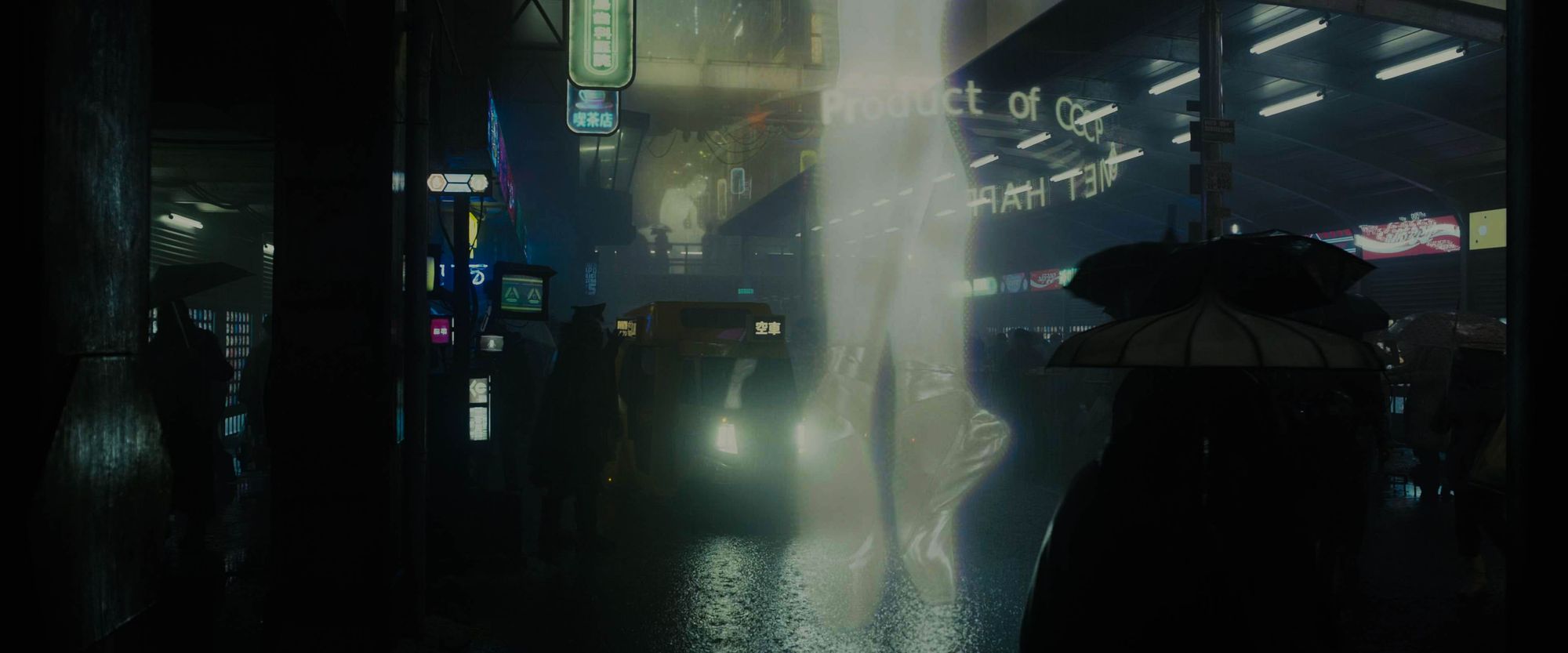
Thirty years later, the replicants are still struggling for freedom, albeit in developed forms. A newer Nexus Model, the Nexus 9, has been created, more docile and obedient and with an extended lifespan.
The new models, now equipped with an extended lifespan, are sent out to retire (a.k.a. “Kill”) the older Nexus 8 models that rebelled against the system of obedient replicant slavery.
The bankrupt Tyrell corporation was bought out by tycoon Niander Wallace, who continued the production of replicants. The sequel follows the protagonist “K,” a Nexus 9 replicant on the hunt for the remaining Nexus 8 models, who discovers an earth-shattering secret that connects the events from the Blade Runner film with the sequel Blade Runner 2049.
The theme of a forbidden, impossible love story between Deckart and replicant Rachael finds its reference in the impossible love story between K and the hologram Joi.
Villeneuve made subtle references to the first Blade Runner film by referencing the iconic unicorn origami from the first film when K visits retired police officer Gaff, one of the protagonists of the first film, in the retirement home.
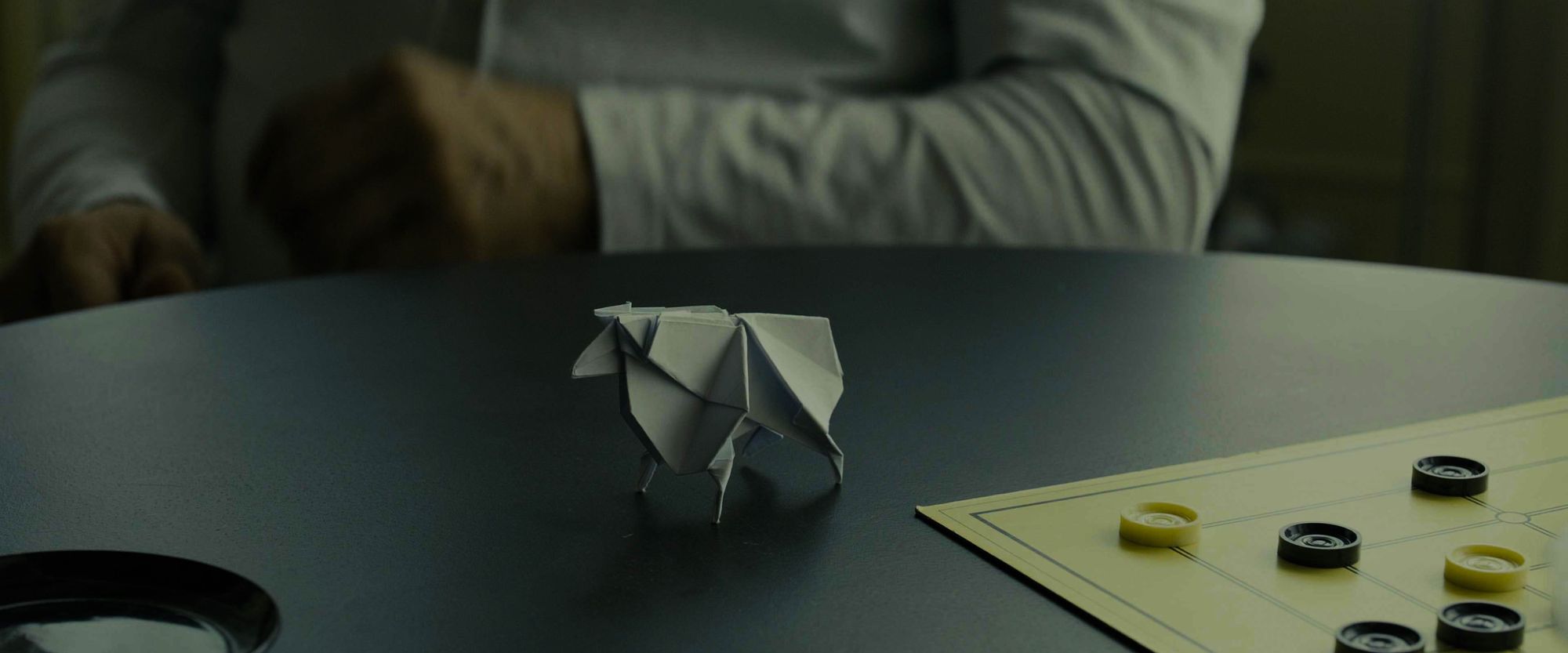
But this time, the origami model is not a unicorn; it’s a sheep, a reference to the book Do Androids Dream of Electric Sheep by Philip K. Dick. It could also be viewed as a message to K that he is not the special unicorn he might think he is.
One visual element that connects both films is the eye symbol. Just as in the first film, Villeneuve incorporates close-up shots of eyes.
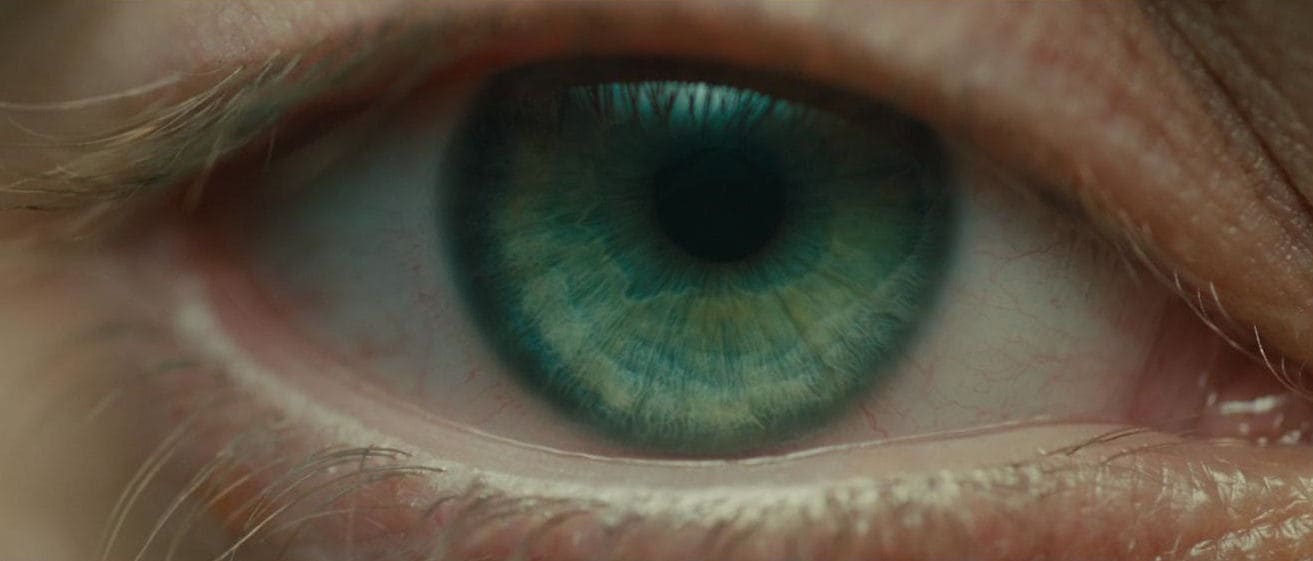
Wallace Niander, the successor Tycoon to Eldon Tyrell, is blind, whereas Eldon was wearing big glasses throughout the first Blade Runner film. The glasses of Eldon and the blindness of Wallace symbolize their inability to truly “see” the pain and the consequences of their actions as the manufacturer of human-like replicants.
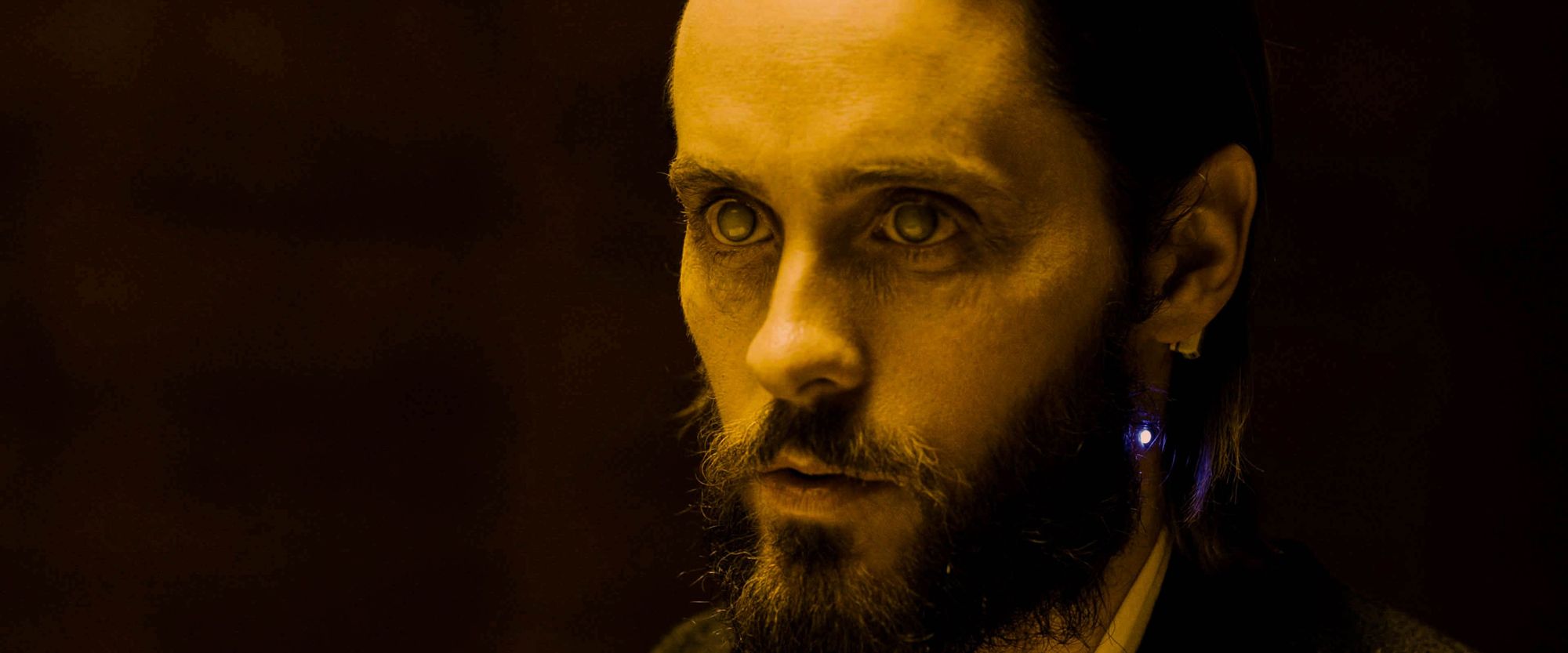
The eyes are the only body part to unveil if a being in human form is a real human or a replicant. In the first film, the Voight-Kampff machine is used to identify a replicant; in Blade Runner 2049, technology has progressed, and the protagonist K uses a lens that points at the eyes and reveals the identity of the scanned object, comparable to a QR scanner.
Villeneuve shows us a dystopian universe where technology has visibly progressed thirty years later, but both films' stories are organically connected. He incorporates motifs, symbols, and color elements from the original film but gives the successor his own masterful handwriting. It was the same motif but painted by another artist.
Grading the apocalypse’s color palette
Color grading is essential for setting the mood and tone of any creative visual piece. In a dark and often bleak-looking experience like Blade Runner, nailing that grim, dystopian essence was a revolutionary feat.
When you consider the sci-fi standard of the time (borne of certain light-saber-swishing Jedi), Blade Runner's aesthetics were the 80s’ real Rebels. In contrast with Star Wars’ bright and cheerful color palette, Blade Runner has a deceivingly subtle spread.

That’s not to say Blade Runner is a visually dull film - it’s a superbly loaded spectrum. The otherwise drab colors of Blade Runner’s crumbling Los Angeles setting are glaringly punctuated with neon lighting and holograms.
Before we delve deeper into the Blade Runners’ color palettes, we recommend you enjoy a brief grounding in the cyberpunk neon color palette.
The moodiest color palette of the 20th century
There are a few key aesthetic differences between Blade Runner’s “Director’s Cut” and the “Final Cut.” The last and truest version of the film was technologically enhanced, featuring a steel-green color grading (similar to the one used in The Matrix films) throughout.
Blade Runner’s color palette is phenomenally varied and balanced, but the predominant steel-green tinge mutes its general tone.
Given Blade Runner’s extremely polluted setting and neo-noir style, it’s unsurprising that there are only a few scenes with sunlight. Deckard’s visit to the pyramid-like Tyrell Corporation building early in the film is one of the few warmly-lit scenes.
Eldon Tyrell’s temple-like office is almost ethereal in design, with its enormous vaulted ceiling and towering columns. The irradiated-looking light that floods this lofty space is reminiscent of contemporary fantasy films of the time.
Our smoggy glimpse of the sun is cut short when Deckard asks for the shutters to be closed.
Tyrell’s space and sickly-golden ambiance contrast with most of the witnessed living conditions, a capitalist god perched above washed-out squalor.
Much of the film’s color palette features the complementary pairing of yellow and blue. Shadowy streets that almost seem submerged are dotted with cheery, yellow vehicles.

A gold-heavy scheme returns toward the end of the film when the persecuted replicants headed by Roy Batty (played by Rutger Hauer) confront Eldon Tyrell in his swanky apartment. An arrangement of tall candles floods the space with a flickering and primal intensity, perfectly accompanying Rutger Hauer’s violence.
The color palette of the sequel Blade Runner 2049 is as powerful to the senses and groundbreaking as the one in the first film. The director of photography, Roger Deakins, took inspiration from the color palettes of the first film but developed it further to form its own distinctive aesthetic in Blade Runner 2049.
Yes, we can see once more the bold neon lights and glowing holographic projections contrasted against the nightly dystopian city background. Still, Villeneuve created his own visual language and color symbolism in Blade Runner 2049.
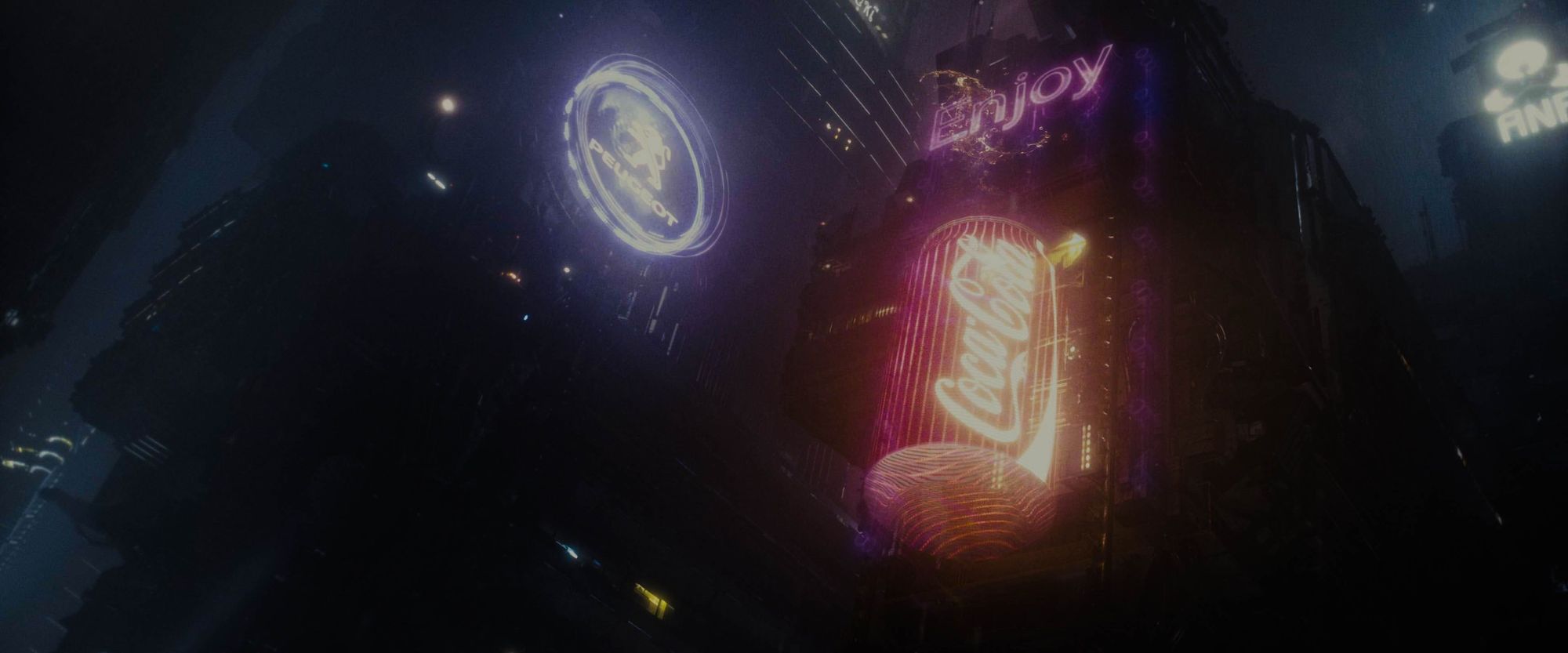
In the scenes where K moves solitary within the city, the settings are blue-lit to visualize the loneliness and isolation of our main protagonist. Generally, blue is often used in sci-fi films to symbolize technical advancement.
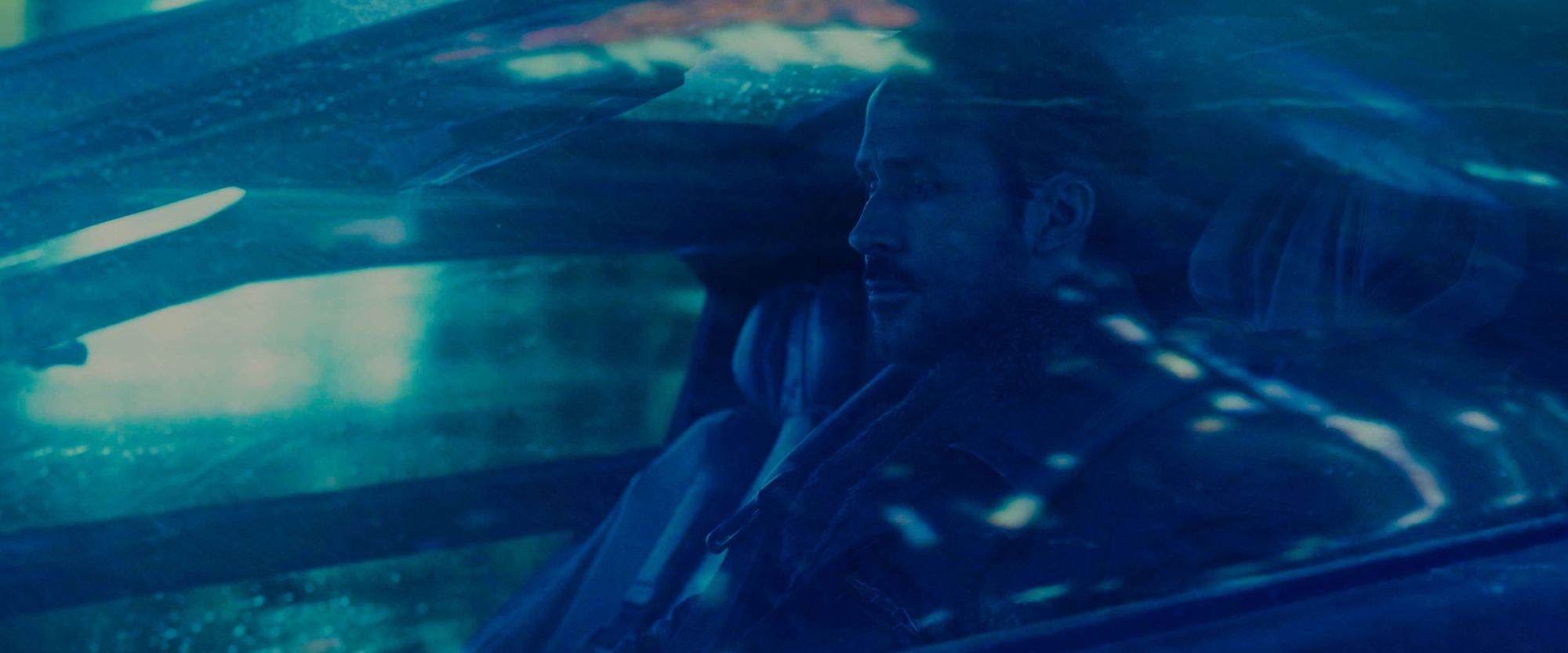
The first Blade Runner film features only a few scenes lit in warm colors, such as the scenes in the office of the Tyrell corporation.
Below, you can see a comparison of the color barcodes of the two Blade Runner films. These color barcodes are created by extracting and compressing every single frame of a movie into a single, colored line.
It is clear to see that the Blade Runner 2049 film contains significantly more warm-colored scenes than the first film.
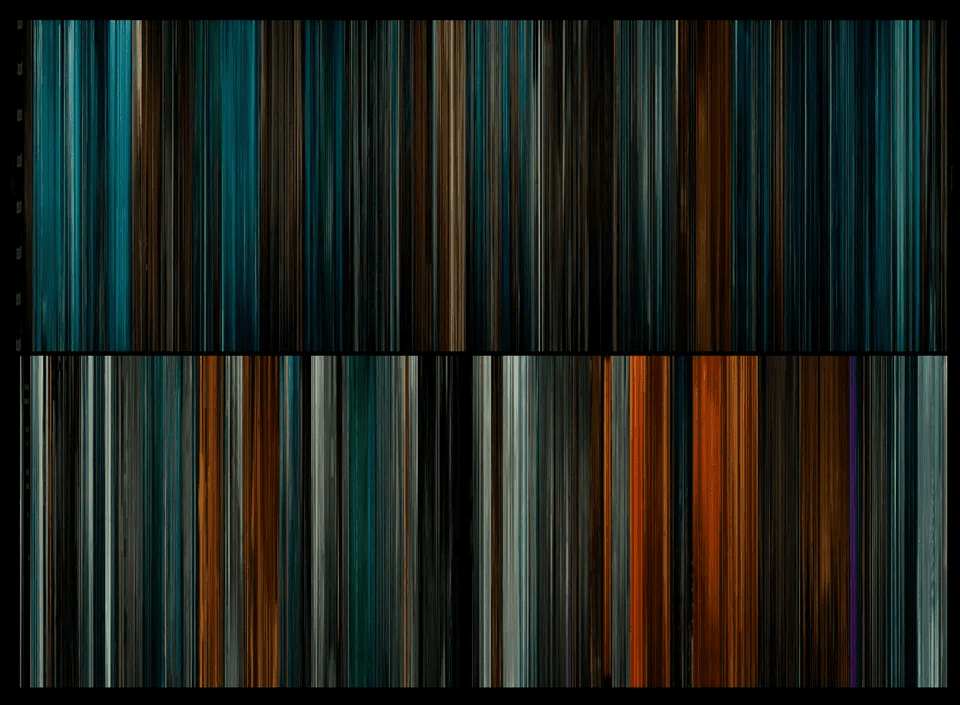
In the scenes of Blade Runner 2049, which were shot in the corporate building of Wallace corporation - the successor company of the Tyrell corporation - Deakins chose a predominantly yellow color scheme created by ring lights, contrasted against sharp geometric shadows produced by the brutalist office building and the soft flickering waves of the water at the bottom of the meeting room.
The yellow color palette sharply contrasted with dramatic backlit shadows in the corporate building of Tyrell and then later in the Wallace corporation building, masterfully connecting the narrative of both films. Interestingly, the only scene with the Replica of the original replicant Rachael takes place in the yellow-colored meeting room of the Wallace corporation.
Ready to create brand assets that pack a punch?
Visit our Academy for free marketing design courses.
Deckart meets her for the first time in the warm-lit building of the Tyrell corporation in the first film. He meets her replica again in the second film in the similarly warm-lit corporate building of the Wallace corporation. The similar color palette with the dramatic shadows heightens the déjà vu Deckart is experiencing in Blade Runner 2049.
Villeneuve uses the color yellow as a symbol of enlightenment. The information bank at the Wallace corporation is yellow. Every time an important detail is revealed, the color yellow is incorporated into the scene.
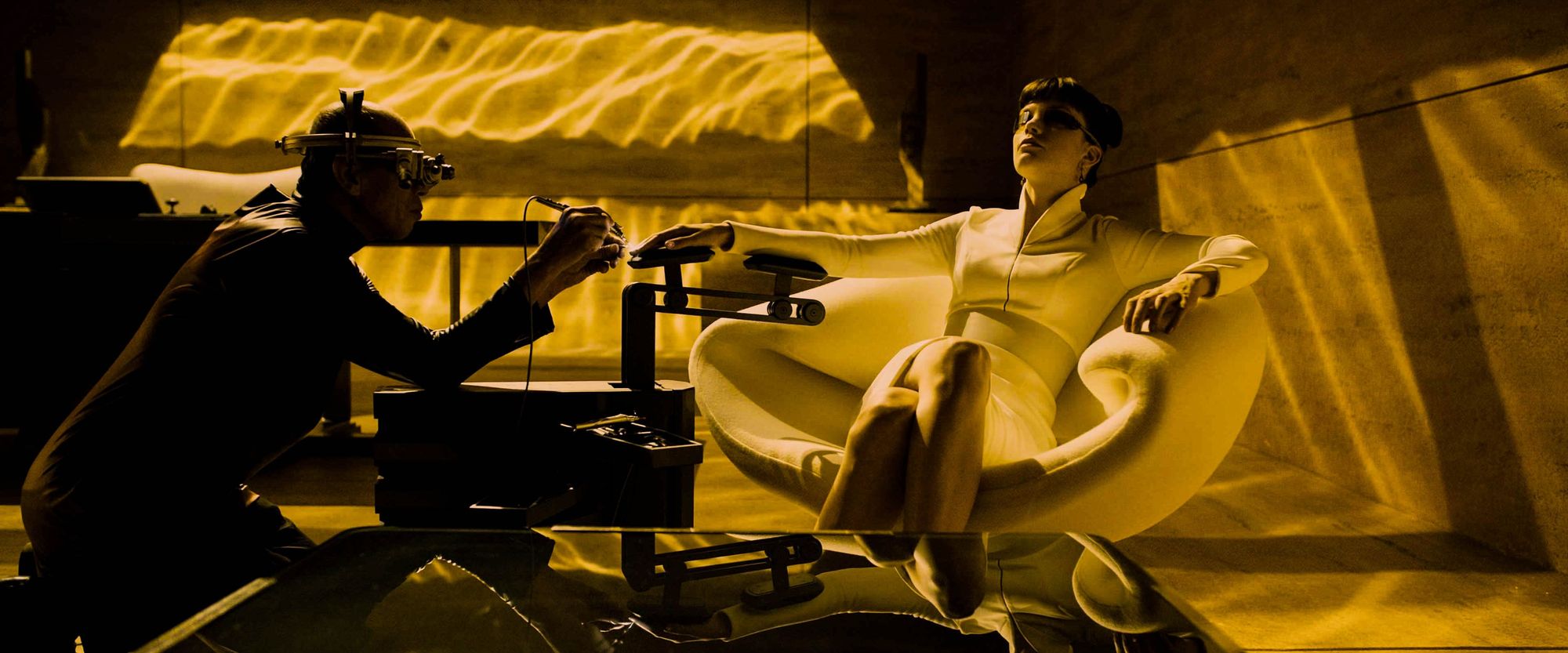
The first Blade Runner film featured a warm, yellow-tinged color palette in very few scenes, but in Blade Runner 2049, the warm-toned color palette was used more extensively.
Another crucial chapter that features warm tones is the Las Vegas desert chapter. The scenes outside with dilapidated remains of once glamorous sculptures are drenched in a saturated, intense orange. The orange symbolizes a warning of impending danger and transition within the film plot. The color gets integrated shortly before the protagonist meets Deckart, and the story takes a dramatic turn.
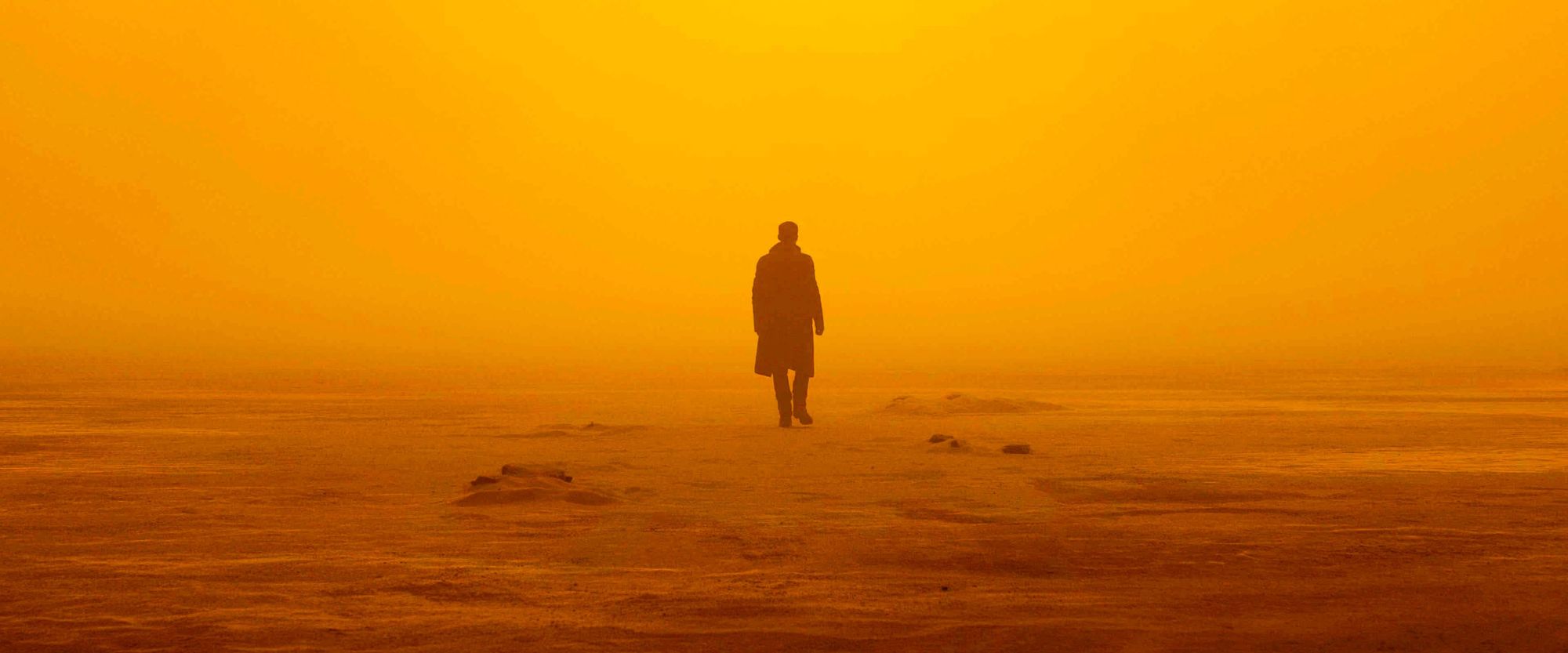
The scenes where the protagonist sees a larger-than-life-sized hologram of Joi projected in the cityscape are predominantly pink and purple colored.
Pink as a color represents romance but also kitsch and harmlessness. The color tone symbolizes Joi's overly sweet, manufactured love, a hologram and product bought by K to soothe his loneliness.
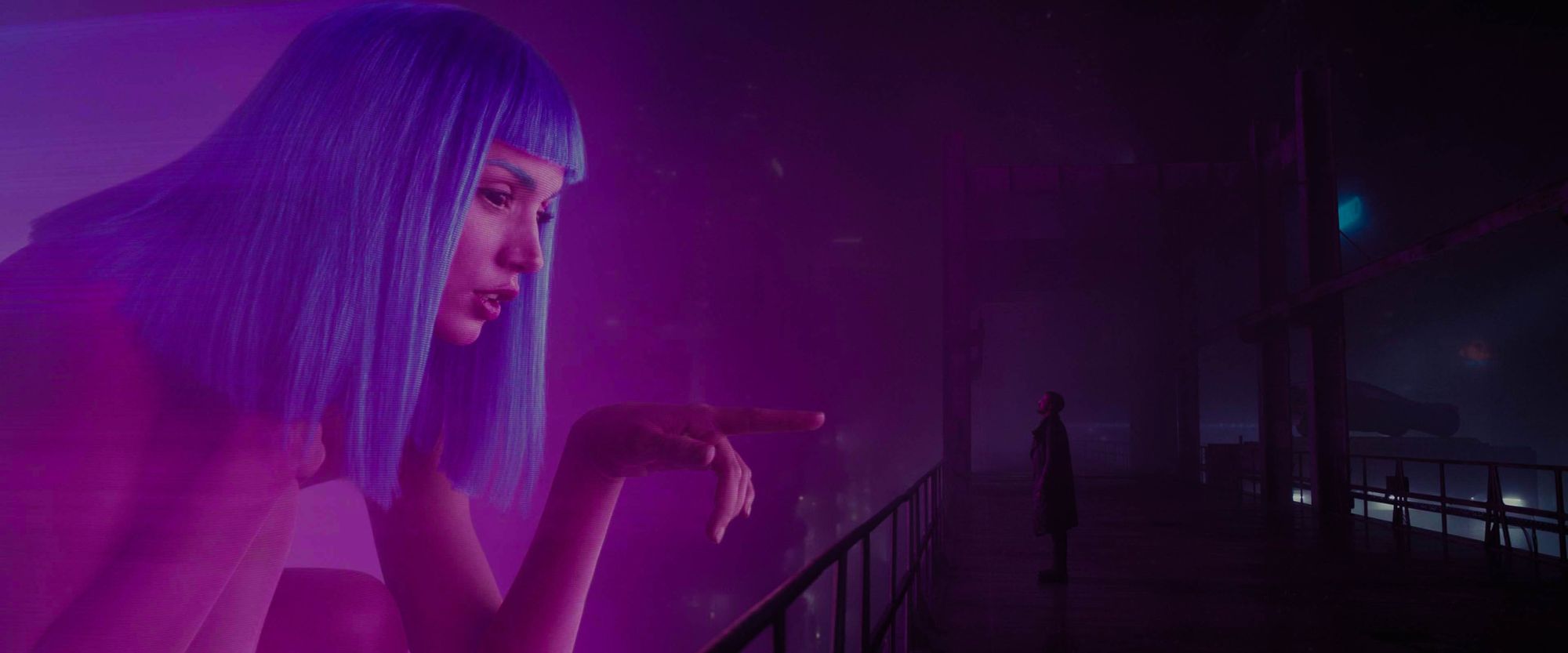
The pink lulls K in and gives him a break of canned digital warmth and love from all the intensity and drama of the orange-colored dramatic events of the Las Vegas desert and the coldness and inhumanity of the cold cityscape.
The color green is used in almost every scene in which K's digital companion Joi is featured.
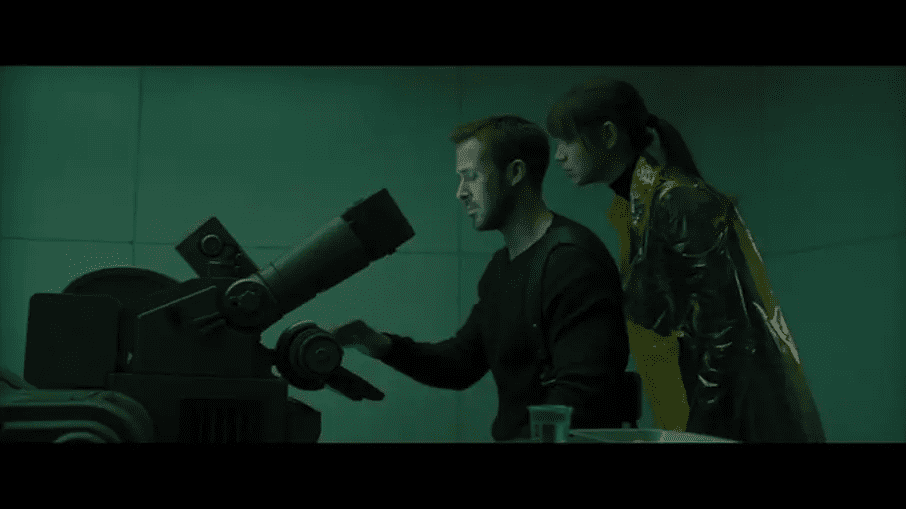
When the replicant K meets Dr. Ana Stelline in the illusory forest, she projects with her imagination. Green represents life, companionship, and nature; the color has a slightly different connotation than in the first Blade Runner film.
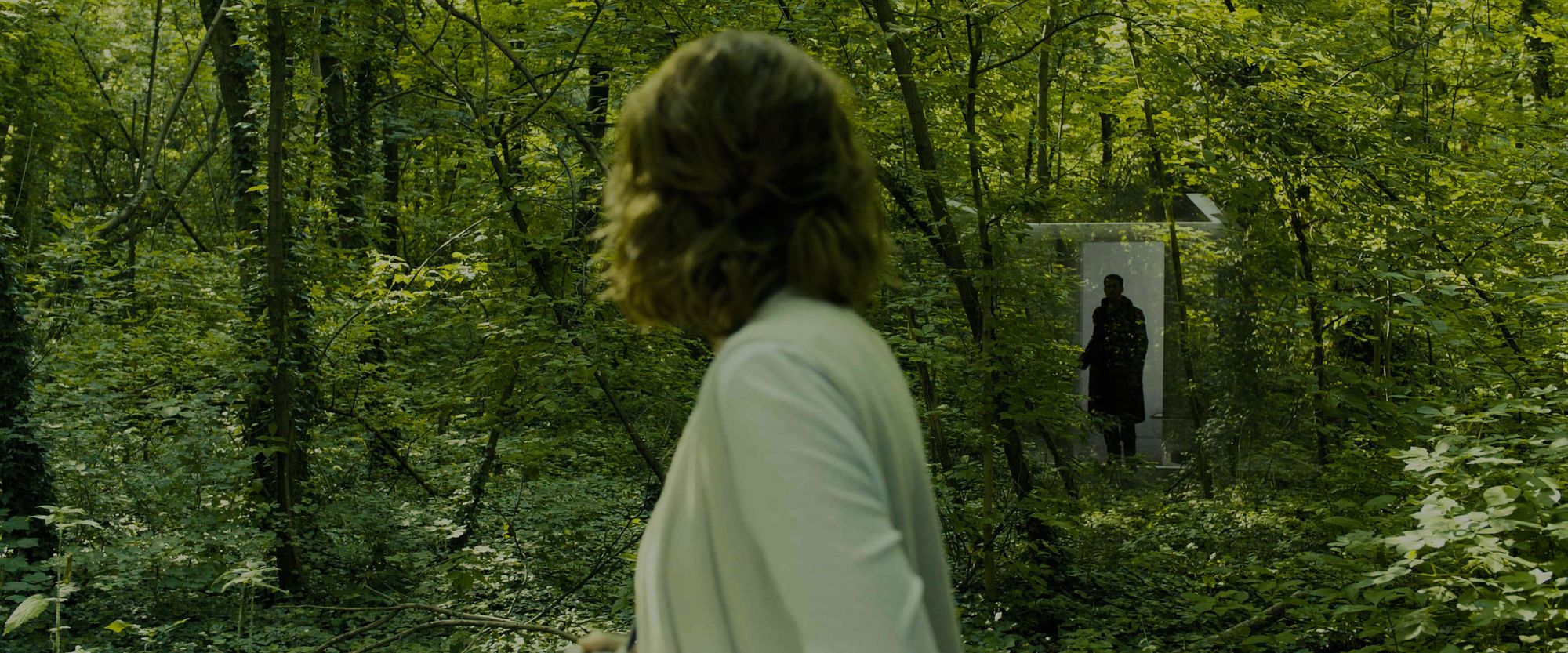
The color white was used in the Blade Runner 2049 film to symbolize truth, information, and solitude. To visualize the solitary effect, the scenes dominated by white are very scarce and minimalistic in their frame composition.
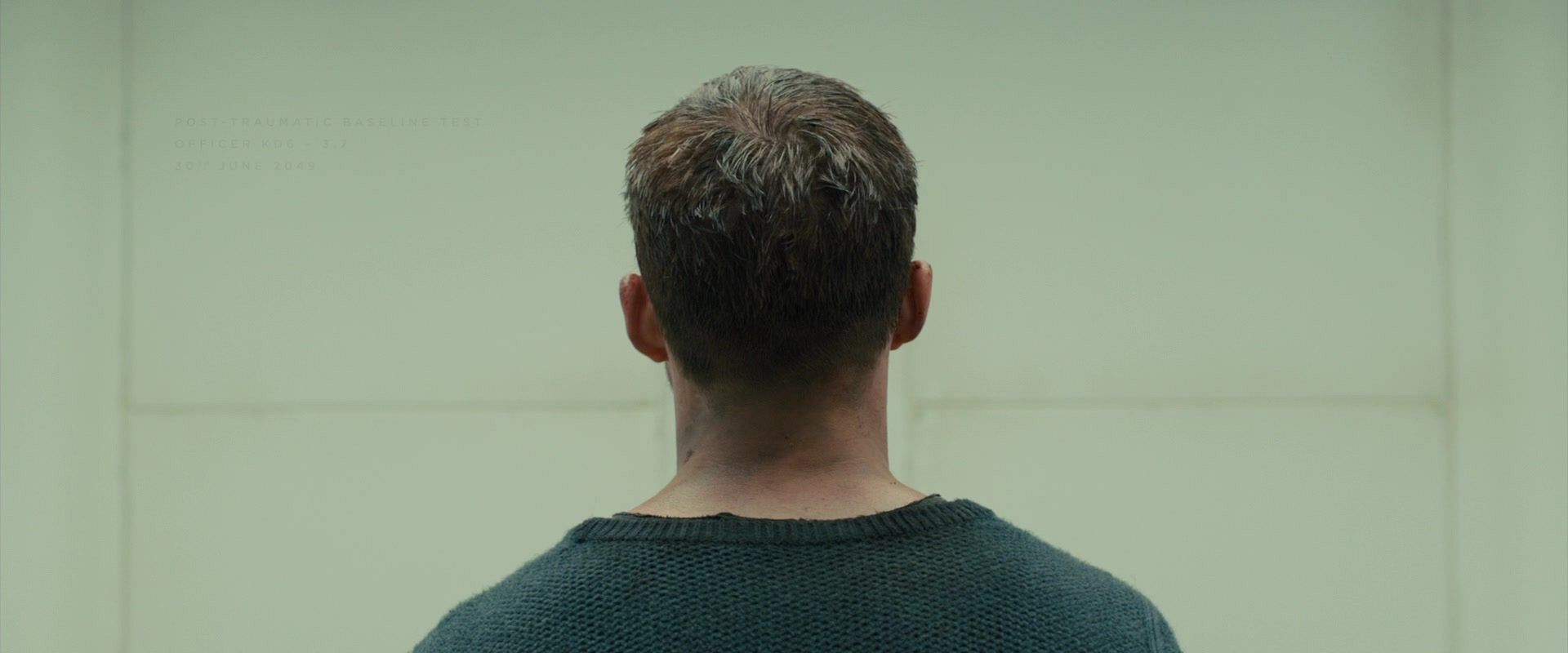
The film starts with K bathed in foggy white, arriving at the farm of Nexus 8 replicant Sapper Morton to “retire“ him.
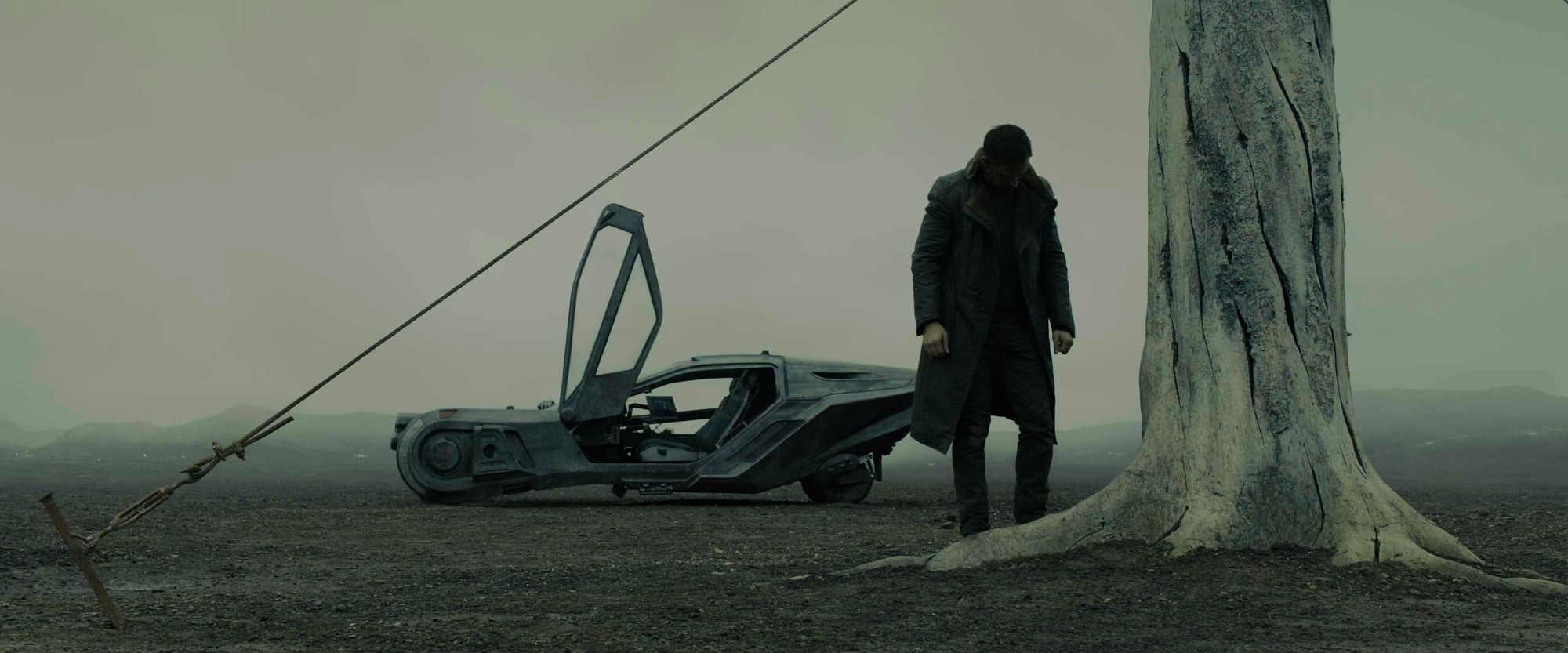
In the final scene, where K solves the mystery of his identity, he sinks into the white foggy embrace of falling snow on the stairs after bringing Deckart to meet his daughter. The film begins with a quest for the truth in white and ends in white after the truth is revealed.
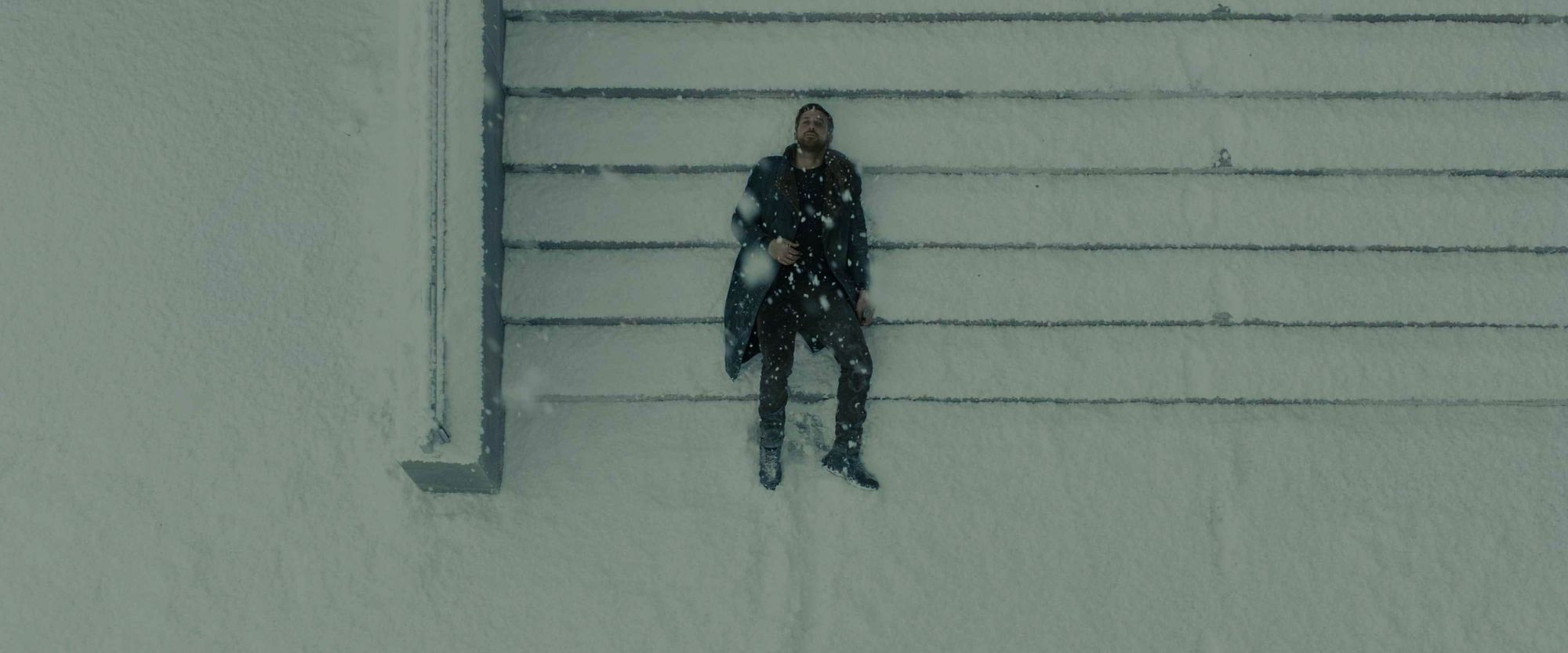
A cinematographic ode to classic film
Blade Runner’s cinematographer Jordan Croneweth deliberately styled his photography after old-school black-and-white films. Scott wanted Blade Runner to emulate Citizen Kane when considering films to use as references.
If you’ve watched Orson Welles’ iconic classic, you might have recognized similar quirky camera angles, striking light shafts, and high contrast in Blade Runner.

Special effects supervisor David Dryer won an Academy Award for his work on Blade Runner. A well-deserved honor, considering how much homework the special effects wizard undertook. Dryer printed and studied black-and-white stills of the film to the point that he wished he could take all color out.
Despite the crew’s fascination with shades of gray, neon lighting is ironically prevalent throughout much of the film. Countless neon signs, letters, and strips are littered throughout Blade Runner’s surreal sets.
The symbolic craft
According to Croneweth, his technique took a back seat during Blade Runner’s production. The key focus was always on the narrative and its concepts.
Many have criticized Blade Runner for not having much of a story. Sure, it’s a bit vague, and it takes several watches to appreciate the lore and symbology truly.
Every little detail helps tell Blade Runner’s story and expand its world.
Hovering airships’ invasive Xenon spotlight beams lance through apartment buildings, showing this dystopia's invasive and prison-like nature.

Smoke billows and rain pours throughout the film, highlighting futuristic Los Angeles’ unlivable conditions.
Unmotivated shafts of light streak Blade Runner’s sets, enhancing their surreal and unpredictable setting.
Controlling these unorthodox elements was challenging, but combined with cinematographer Jordan Croneweth’s framing, resulted in genuinely jarring shots.
All the lonely people
Cronweth generally positioned Blade Runner’s actors to the sides of the screen, rarely centering characters during shots. This sidelining was stressed by stark lighting contrasts, smog, rain, and dilapidated architecture to create a powerful sense of isolation and abandonment.
Actors are often only half-lit, with much of their faces in shadow, suggesting that everyone has something to hide.

Ironically, Deckard and the replicants he pursues have been mutually disenfranchised by this failed society. This is a lonely and degraded world, masterfully realized by Cronweth’s arrangements and director Ridley Scott’s obsessive attention to detail.
Scott is often attributed for landing Blade Runner’s meticulous visual composition. Silent, painstaking hours passed on set while the director fussed over minute details and lined up shots for optimal compositions.
When director Dennis Villeneuve shot Blade Runner 2049, he worked together with legendary cinematographer Roger Deakins to create a stunning visual language that could match and reference that of the first film in visual brilliance. Still, he was able to develop his own distinctive aesthetic. Deakins deservedly received for his work on Blade Runner 2049 his first Oscar for Best Cinematography after fourteen (!) previous nominations.
Vectornator is now Linearity Curve.
Learn more about our recent rebrand and how we chose our new colors.
Deakins swapped the hard contrasting lighting style of the original Blade Runner film for his signature soft and diffused lighting technique for Blade Runner 2049.
2049’s visual language matches the first Blade Runner film, with its nocturnal, rainy, crowded city streets scenes, its glowing ads, and the passers-by draped in futuristic outfits contrasted against the blueish darkness.
Deakins created the light effects of Blade Runner with practical lighting, as he believes that this lighting technique creates a realism that makes a scene more believable and real, an approach closely connected to the cinematic approach of Villeneuve, preferring real-world scene sets and props to green screen sets created in post-production. For Deakins, the light needs justification, a source to take up space in the scene, and the effect of the light to be real.
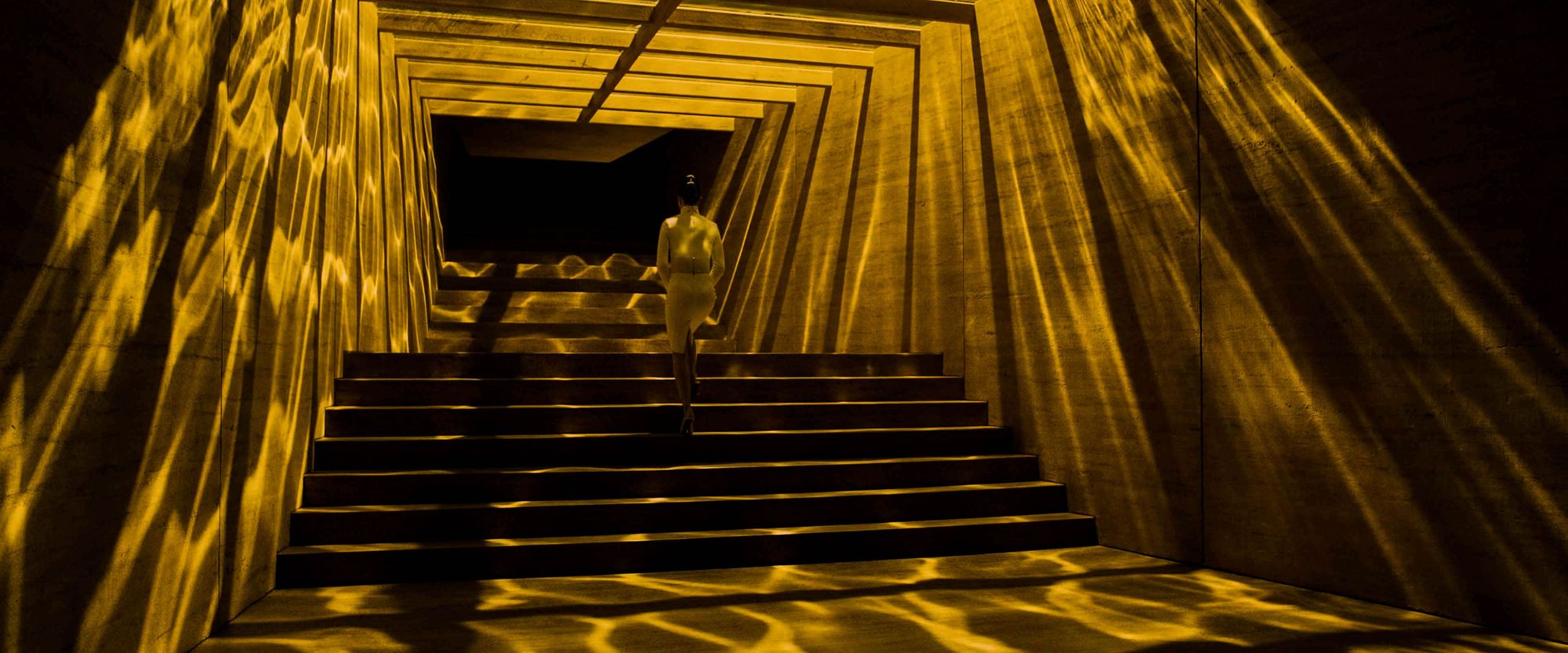
The breathtaking caustic wave reflections on the walls of the meeting room inside the Wallace Corporation building are created by actual moving water at the bottom of the scene. Deakins even custom-made many of the light fixtures used in Blade Runner 2049.
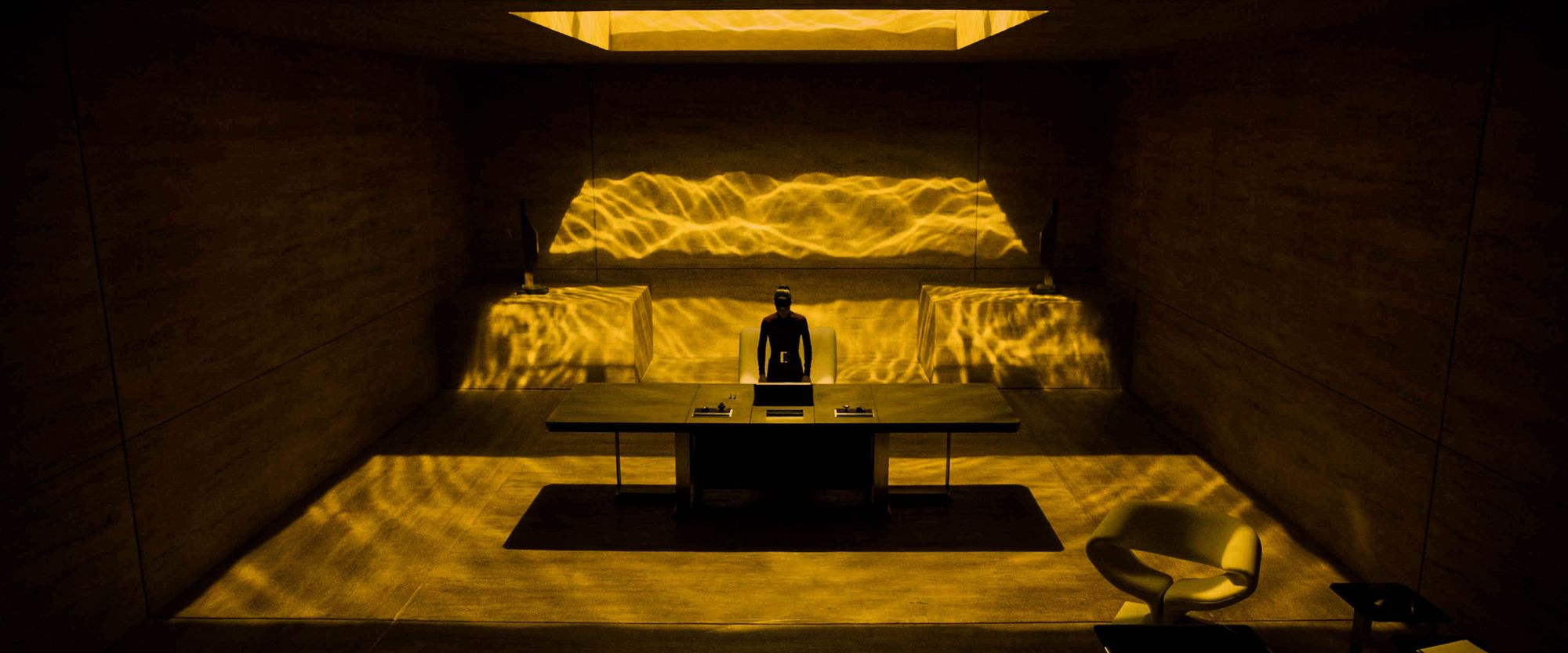
Ridley Scott created a rainy and gloomy dystopian world. Born and raised in Vancouver, Villeneuve chose to create a cold and snow-covered world with sharply contrasting dry desert elements. One of the main elements of the visual language in the sequel is the extensive use of fog, which diffuses and spreads the harsh color of the city lights within the scene that picks up on the dream-like hazy look of the first film.
The fog obstructs the view in almost all outdoor shots and even in many indoor scenes. In the outdoor settings,, the fog symbolizes the destruction of nature. The air is so toxic that it seems even difficult to breathe.
The fog is used as an element of storytelling, as key elements are unobstructed by the fog, automatically guiding the eye of the viewer within the scene.
Blade Runner 2049 was mainly shot with a single camera in every scene with Deakins behind it, an unusual approach as in contemporary film productions, multiple cameras are used to shoot a scene. The landscape shots are minimalistic, wide, and visually impactful, filmed with a wide-angle lens.
The scenes are mostly shot with a wide-angle lens, which allows the frame to keep a large depth of field. This aesthetic leaves room for the surroundings to be fully incorporated within the frame, and the characters connect fully with the world around them. Deakins mainly used stable footage, giving the viewer time to digest the images and creating a painting-like cinematic effect.
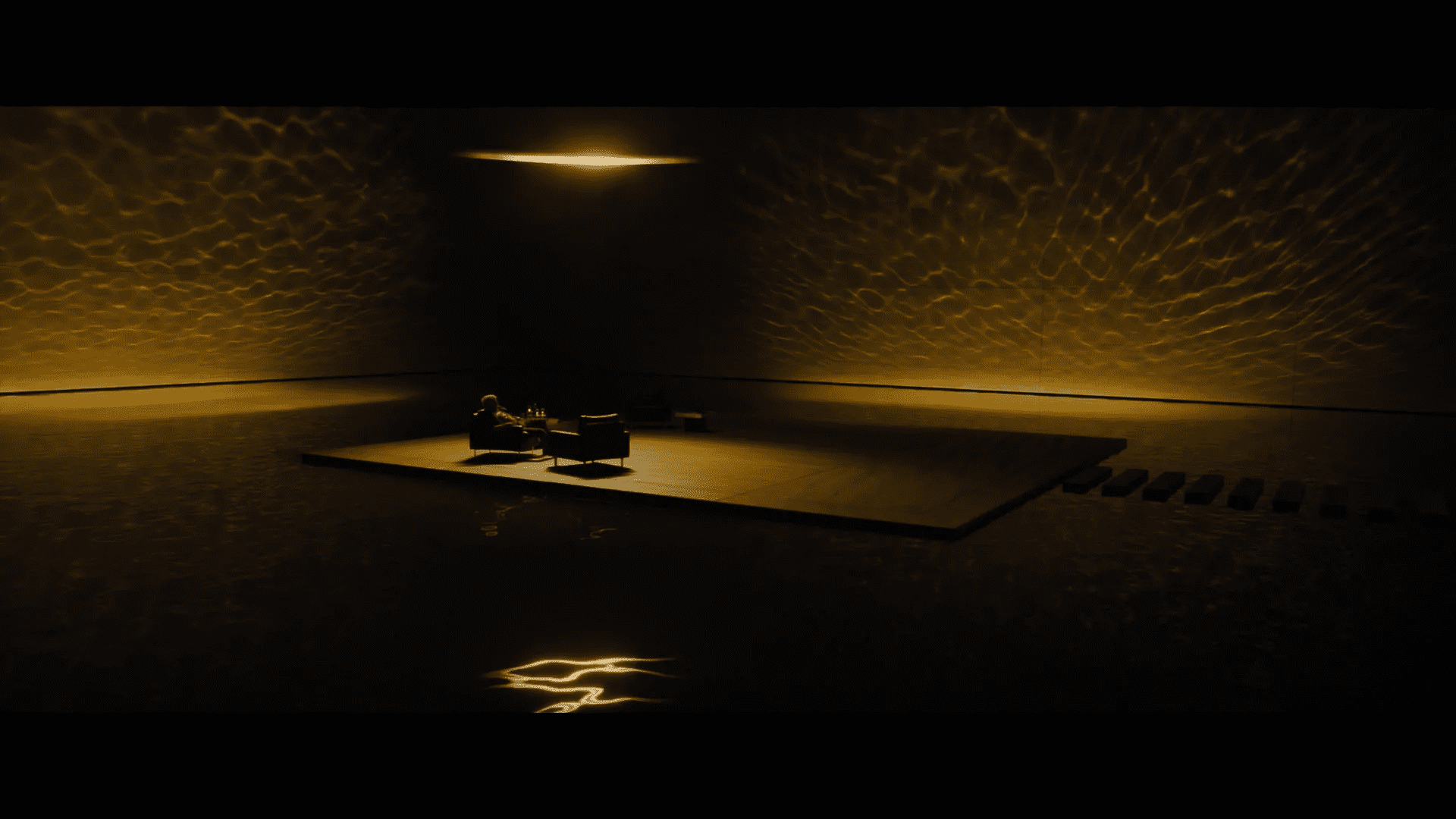
The camera shots composed by Deakins make frequent use of the compositor elements of the rule of thirds, the golden ratio, centered composition, frame within frames, the Fibonacci spiral, triangle, and symmetrical composition and leading lines.
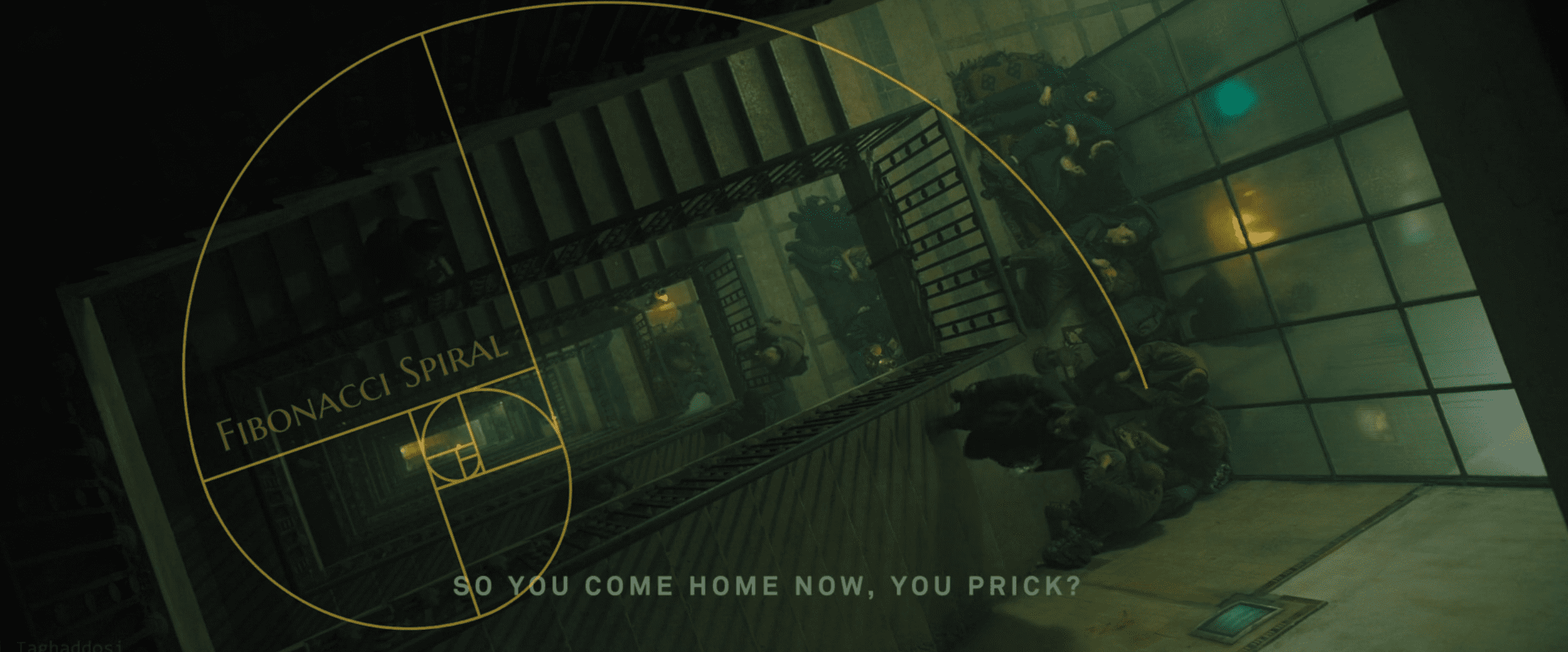
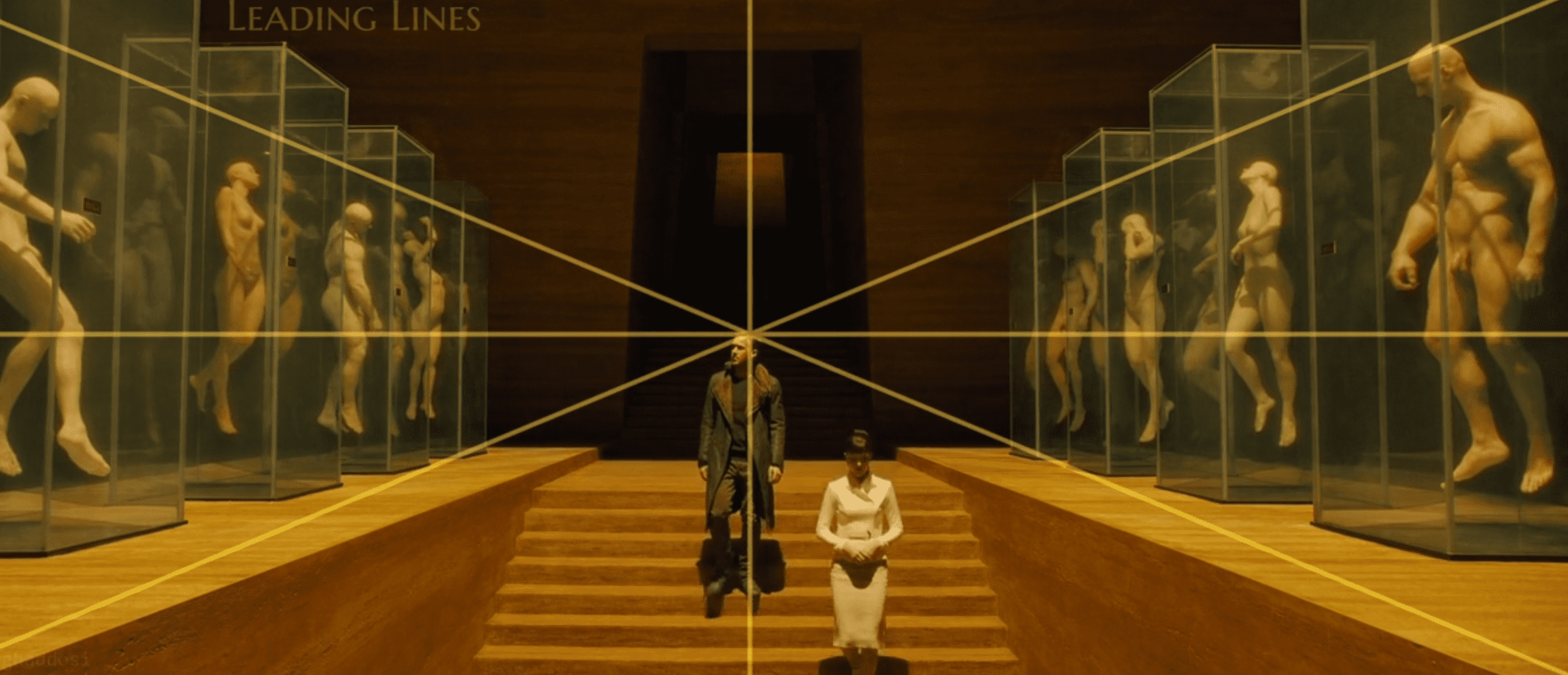
The architecture of the Wallace corporation interior is a prime example of the masterful use of brutalist architectural geometric lines to create leading lines within the shot to direct the eye of the viewer.
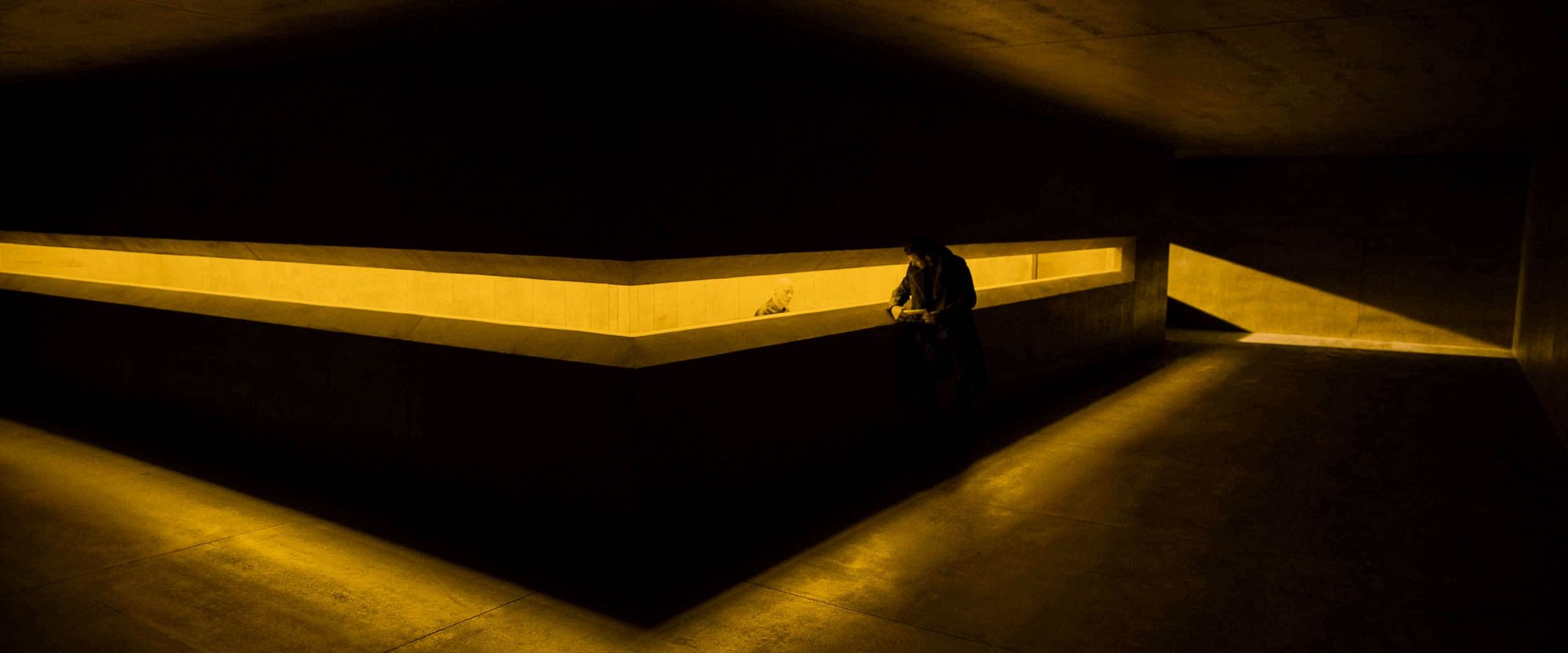
The visual aesthetic is a crucial element of the storytelling in the 2049 film, like in the first Blade Runner film directed by Scott Ridley.
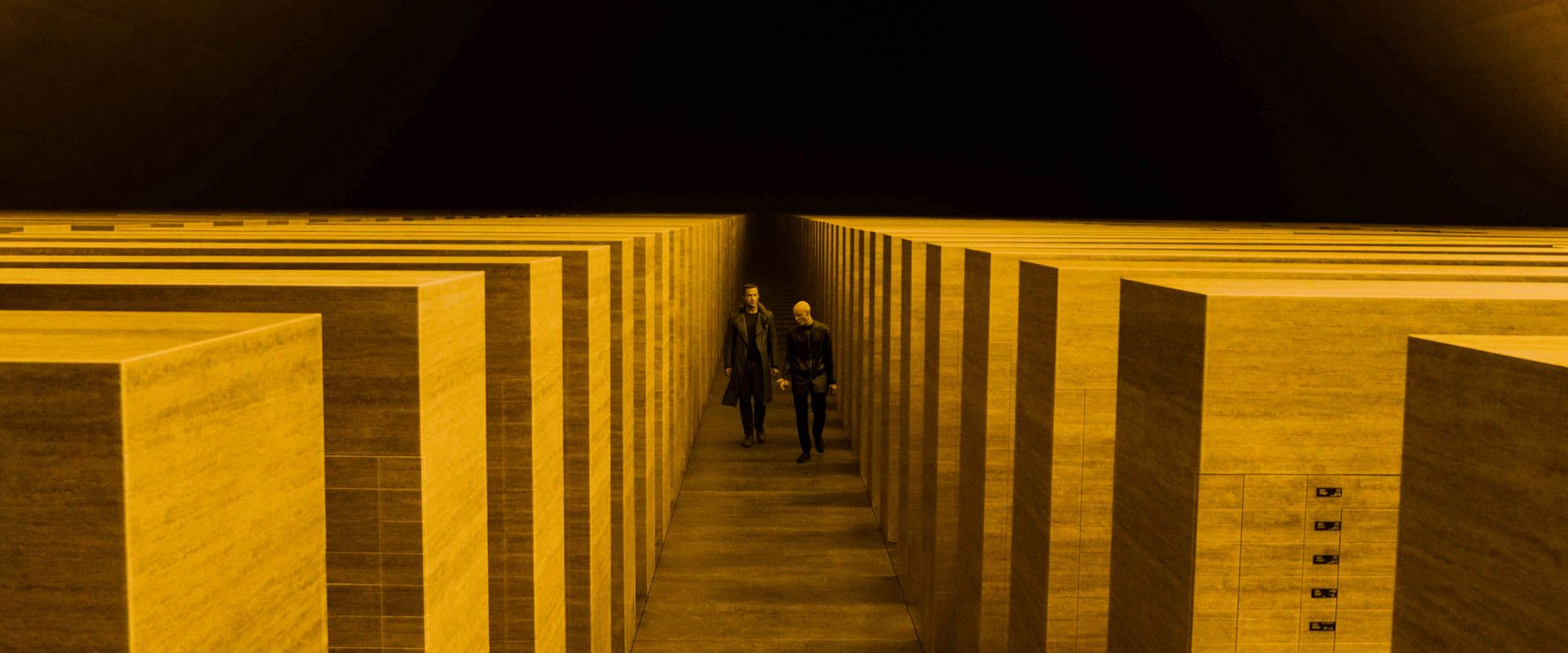
Futurist sets with a historical charm
Blade Runner’s opening shot gives a bird’s-eye view of a hellish industrial complex called “Hades.” Titanic factories belch columns of flame over an insufferably polluted and industrialized city.
We’re immediately left wondering, how did we get here?
In our world, Los Angeles is a vibrant and complex city infamous for its stark contrasts. Idyllic, lush suburbs like Beverly Hills are only a fifteen-minute drive away from Skid Row’s abject poverty and degradation.
Blade Runner aggravates and fast-forwards this imbalance to its tipping point. It might all be science fiction, but sociologists give Scott’s grim predictions credence.
A terrifying depiction of end-stage capitalism
Our story is set in a futuristic Los Angeles that current residents like Tom Cruise and Sandra Bullock might not appreciate. `
Airships whizz between monolithic corporate towers that dominate the neglected yet recognizable remains of the American city buried far below.
Incessant acid rain pelts the jostling pedestrians forced to carry fluorescent-tubed umbrellas that help them stand out through all the hazy pollution.
Advertising is inescapable, with monumental digital billboards plastered on almost every building.
Special Photographics Effect Supervisor designed this apocalyptic city within two periods, the 40s and the 21st century.

Syd Mead was credited as Blade Runner’s “Visual Futurist” and the genius behind Blade Runner’s asynchronous Los Angeles concept. It was then up to a highly-skilled and patient team of visual and special effects artists to build that vision.
Matte artist Matthew Yuricich painted the film’s jaw-dropping matte backdrops. The sunny vista framed by large pillars seen in Eldon Tyrell’s office scene was done by Yuricich using mixed media applied to a huge masonite board.
This epic view was brought to life with a contained color palette as matte paintings were traditionally shot with high-contrast film stock. This approach brings out a flat piece’s color latitude.
Miniatures on a massive scale
Have you ever watched a classic, pre-CGI sci-fi film and thought, “Damn, this looks so much better!”
Before filmmakers could generate whole worlds with their super-computers, miniature artists and model builders were tasked with putting tools to the imagination.
Visual effects artist Mark Stetson and his team painstakingly but lovingly built Blade Runner’s dystopian Los Angeles from the ground up. They crafted countless futuristic and historic buildings, vehicles, and various urban bits and bobs, all systematically fitted together and wired with miles of fiber optic cables.
Stetson and co. added additional detail to models like Eldon Tyrell’s monumental Tyrell Corporation building using the unpleasant but effective acid etching process.

More traditional-looking buildings were retrofitted with sprawling pipe networks, vents, and other hideous civil afterthoughts to highlight Los Angeles’ unsustainable and frenzied expansion.
More than three decades have passed between the 1982 production of the first Blade Runner film by Ridley Scott and the 2017 sequel Blade Runner 2049, and tremendous progress has been made in the VFX field. In 2017, it was common practice to film the actors in front of a green screen set, recreate the set via 3D modeling, and combine the footage of the filmed actors and the 3D render pass with compositing software.
When Dennis Villeneuve took on the torch from Ridley to continue the legendary Blade Runner saga, he decided to go against the standard of modern filmmaking during the 2010s. The first Blade Runner film was an example of masterful miniature real-world set design, a tradition Villeneuve decided to continue in 2049.
The sets of Blade Runner 2049 weren’t entirely built digitally in 3D but primarily as real-world sets where the protagonists could move and interact with. Even for the film props used by the protagonists, Villeneuve shunned the visual trends of the 2010s. He let the production team create practical, real-world props used in a real-world set environment.
Instead of allowing the actors to use light-weight touchpads during the film, he equipped them with heavy, more mechanical props reminiscent of those used in the first Blade Runner Film.
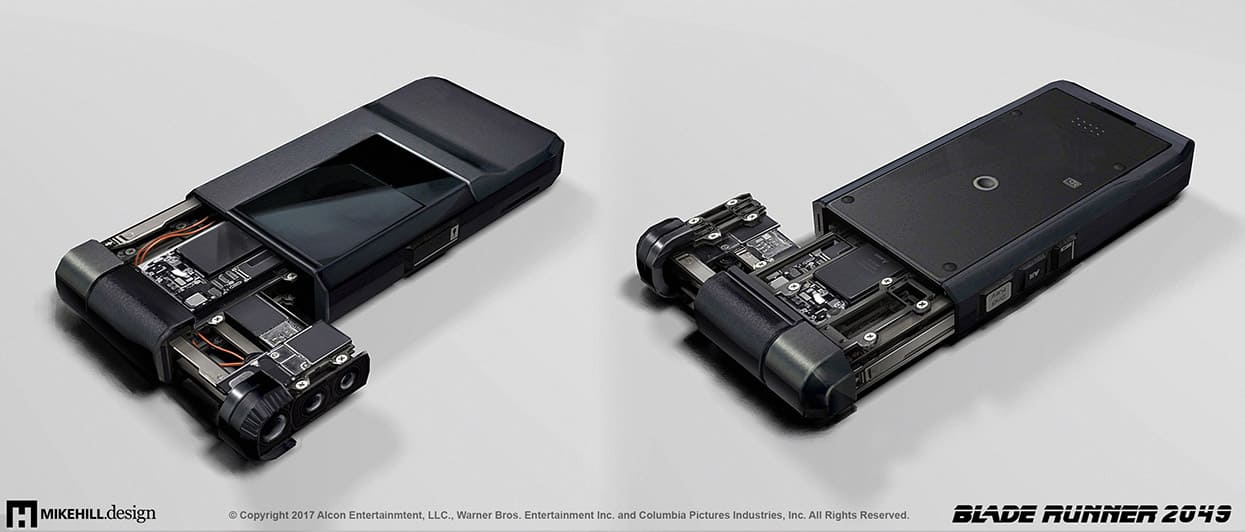
Villeneuve incorporated the visual language of the first film and developed it further into an even more dystopian time 30 years later.
The production design had to reflect the technical progression thirty years later and connect visually to the Blade Runner film from 1982.
He insisted on using real-world props and mainly real-world scene settings, as he believed that it was easier for him to direct the actors and for the protagonists to play their roles interacting with a real setting in the background, which was affirmed by the lead actors Gosling, Ford, and Leto during interviews for the sequel.
Jared Leto mentioned during a promotional interview that he could even hear the dramatic echo of his voice while acting in the water-flooded setting inside the company building of the Wallace corporation. The echo of Leto's voice in the Wallace corporation meeting room was as real as the reflections of water on the walls.
For many shots that featured panoramas with high-tech buildings, concept miniatures were created by the acclaimed Weta workshop under the leadership of senior art director Ben Milsom, combined and shot with matte painting backgrounds, and later integrated with a 3D rendering pass in the VFX pipeline.
Like in the first Blade Runner film; miniatures were filmed against a matte painting backdrop to give the second film an analog vibe. Deak Ferrand from Rodeo [FX], one of the best contemporary matte painters, was responsible for the matte paintings.
The miniatures of the main buildings (like the LAPD HQ and Wallace corporate structure) were so massive that some had to be transported to the set in several pieces.
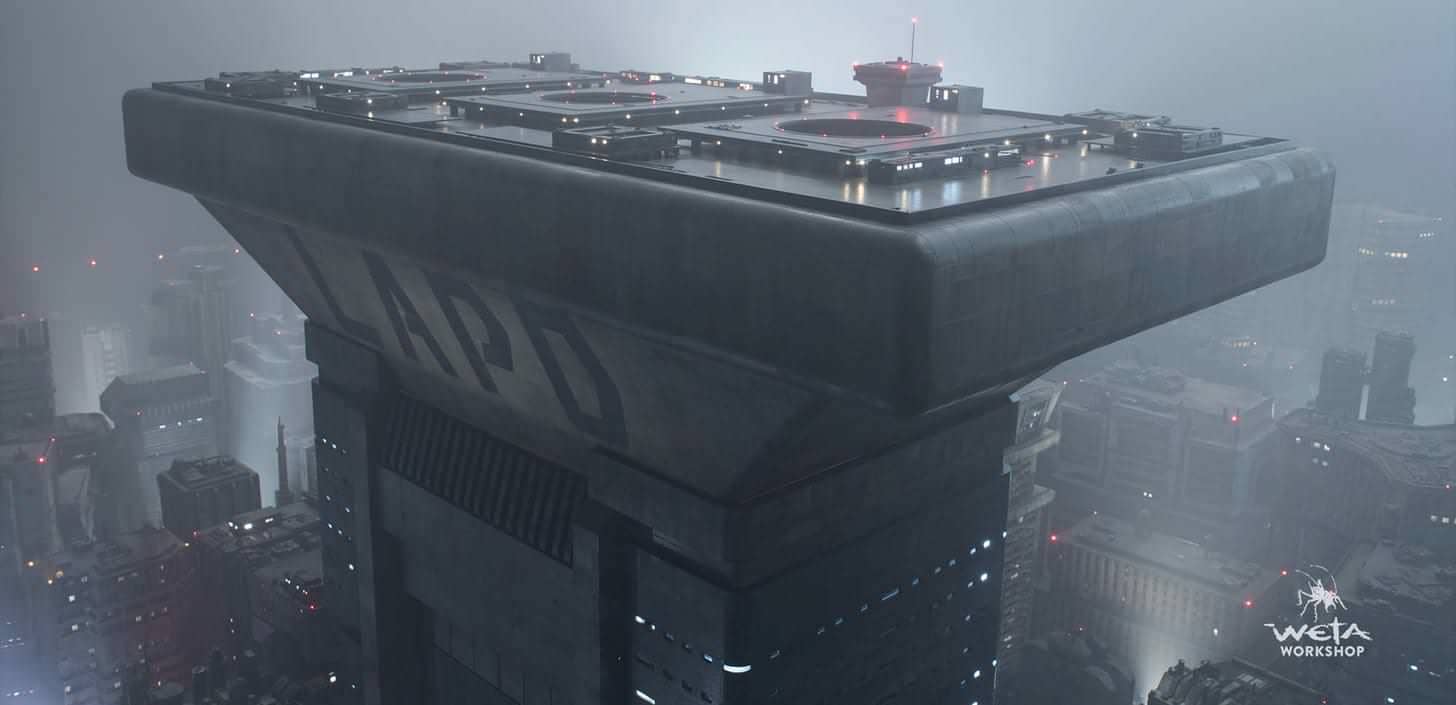
Blade Runner 2049 features several visually outstanding sets and landscapes; prominent here is the office building of the Wallace corporation consisting of brutalist geometric shapes flooded in yellow artificial light accentuated by moving water reflections. It was a real-world set with minimal enhancements added in post-production.
For the Las Vegas desert scenes, Villeneuve collaborated with the legendary creator of the set design for Blade Runner, Tron, and Alien, Syd Mead. It was the last creative gift to the film world from the brilliant and visionary set designer, who passed away in 2019.
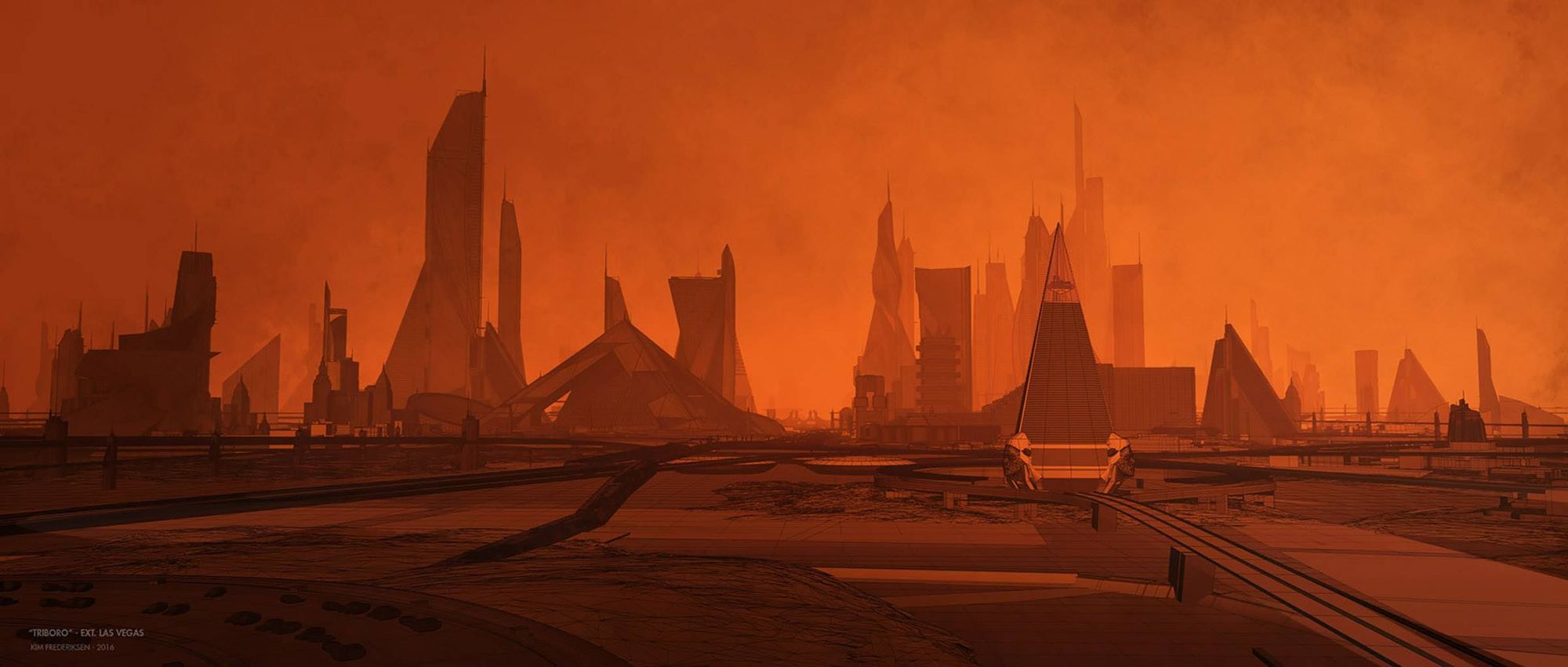
But one aspect of the film design benefitted dramatically from the advancement in CGI in the 35 years that passed between the two films, and that was the visualization of holograms. Special effects supervisor John Nelson had a lifetime opportunity to create the holograms for Blade Runner 2049.
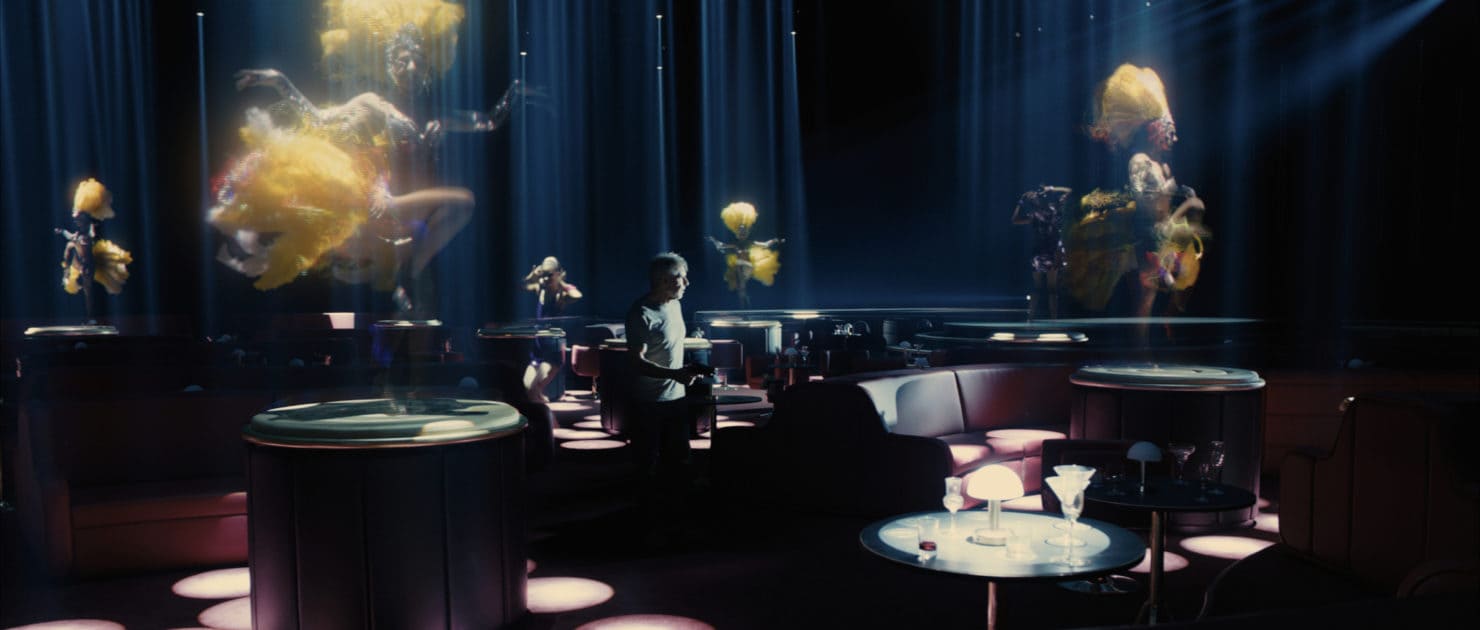
He created with his team the holographic versions of Elvis, Marylin Monroe, and Frank Sinatra, holograms appearing in the crowded city streets, the young version of the actress Sean Young portraying a second version of the replicant Rachael, and the holographic character Joi.
Villeneuve didn’t want the holograms to look glitzy and glamorous; he wanted them to look real and have real volume while rotating their bodies. The images of the actors were mapped on 3D models, which allowed the holographic images to project a volumetric look to the viewer.
The most challenging part for the VFX team was the digital resurrection of a young 1982 version of the actress Sean Young as the replicant version of Rachael 2.0.
The replicant Rachel enters the meeting room out of the shadows of the Tyrell Corporation in the first film and meets a young Deckard. Thirty years later, a copy of her steps out of the shadows of the Wallace corporation's meeting room, causing the visibly aged Deckard one of the most heartbreaking déjà-vu moments in cinematic history.
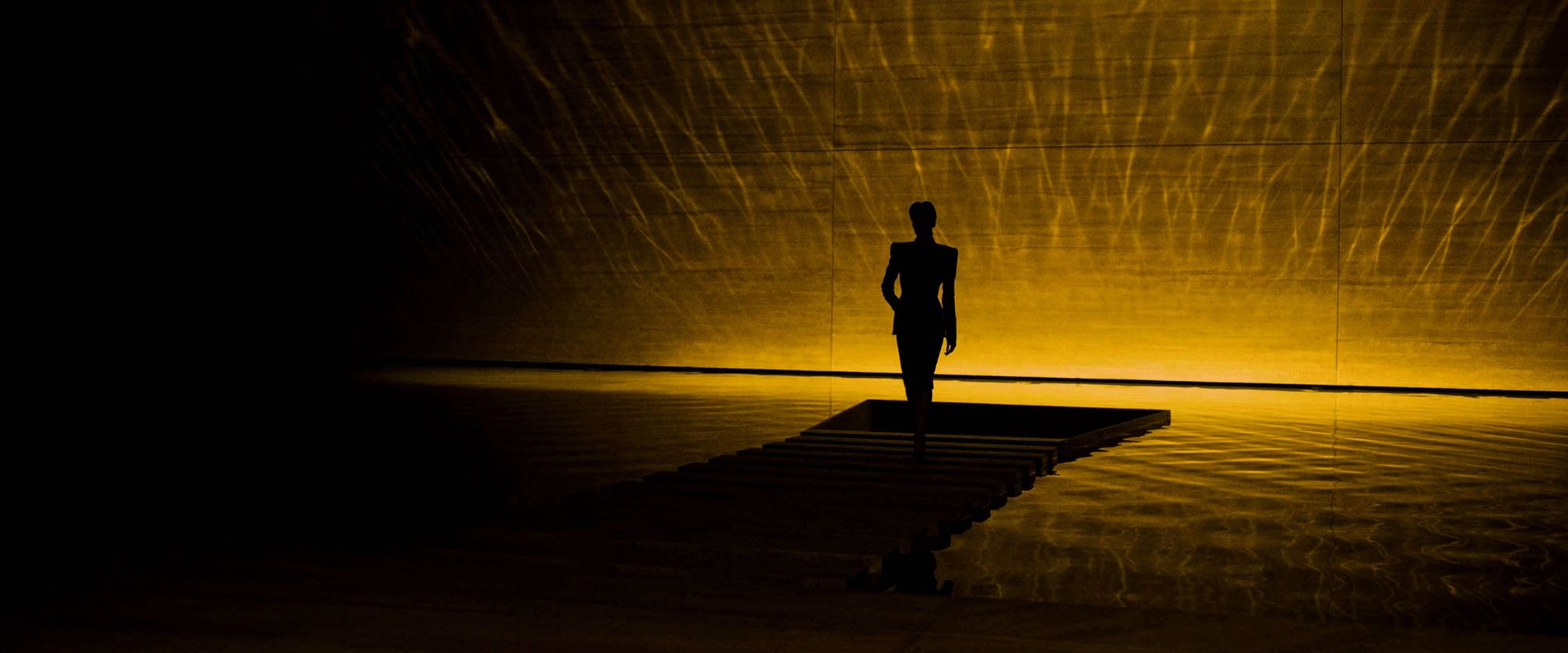
The stand-in actress Loren Peta doubled in the scene; she wore a replica of the iconic dress and donned an identical hairstyle. In her face were tracking markers positioned so that the 3D model of a young Sean Young's head could be superimposed digitally on the head of the stand-in actress.
The head of the actress Sean Young was digitalized by scanning her skull, and on the scanned 3D skull model was digitally added skin, lashes, eyes, teeth, and color texture in 3D. Rendered caustics and sub-surface scattering were used to make the eyes and skin as life-like as possible.
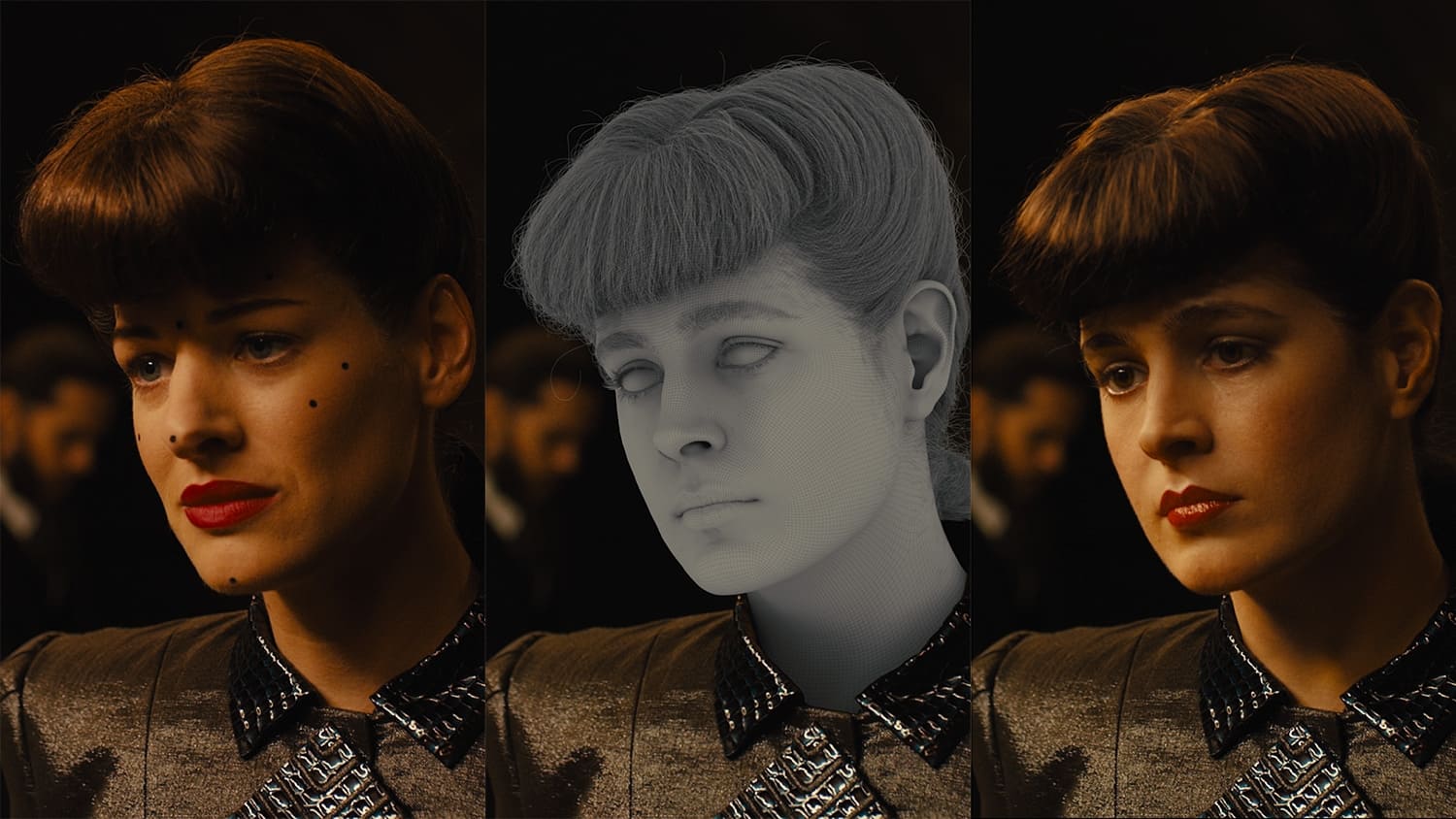
The resurfacing of a young Rachael 2.0 thirty years later in Blade Runner 2049 is one of the best examples of a storyline made possible using contemporary digital de-aging advancements in filmmaking.
The film Blade Runner 2049 brilliantly fused cutting-edge digital technology with the haptic analog feel of the first Blade Runner film.
Wrapping up
Blade Runner might not be everyone’s cup of tea, but we believe the masterpiece has something in it for everyone. Beyond its striking visuals, rousing score, and complex plot, Blade Runner is a film about human identity and relationships.
It’s an infinitely rewatchable type of film, especially if you need inspiration for your next design. You’ll find yourself pausing the movie every few minutes, finding new hidden detail and quirks that are hard to find with a single viewing.
We hope you’ve gained a new appreciation for Blade Runner even if you’ve watched it several times already. And if you’ve never seen it, now you have the perfect grounding to do so!
Often, film sequels are made with disastrous results, as the main objective is to make money off an existing fan base or franchise. Additionally, the first Blade Runner was so iconic and masterfully filmed it set a mark so staggeringly high that it seemed unreachable.
Villeneuve was fully aware of the brilliance of the first Blade Runner film and the tremendous responsibility of directing a sequel to a timeless masterpiece and creating a worthy successor that enriched and continued the story of the first film in a meaningful way.
The probability of Villeneuve creating a sequel that could be a worthy successor of the first film was as likely as an android getting pregnant. Still, Villeneuve was able to create a miracle by producing a worthy successor with Blade Runner 2049.
This was not about money; it was about honoring the art of filmmaking and creating a sequel that continues the story in a meaningful way and creates a plausible development of the world of the Tyrell corporation 30 years later. The second film can connect and continue the plot, world setting, and original characters in a dystopian setting 30 years later in a convincing way.
The topic of human consciousness, ethics, AI, intimate connections, and love are topics that have become increasingly important since the first Blade Runner was filmed in 1982. Do machines have a soul, a consciousness? Are artificial creations sentient? Do they have dignity and rights? How will advanced AI interact with humans in the future? Will we live in a dystopian technical world devoid of intimate human connections? Questions that we will be forced to answer soon…..

We hope we could inspire you to be creative and draw cyberpunk-inspired artwork! Download Linearity Curve (formerly Vectornator) and share your masterpieces in our community gallery or social media channels!
This piece was written by Marion Gerlinger and Teddy Cipolla. Teddy covered the first Blade Runner film’s analysis and Marion analyzed the sequel, Blade Runner 2049.
Jumpstart
your ideas with
Linearity Curve
Take your designs to the next level.
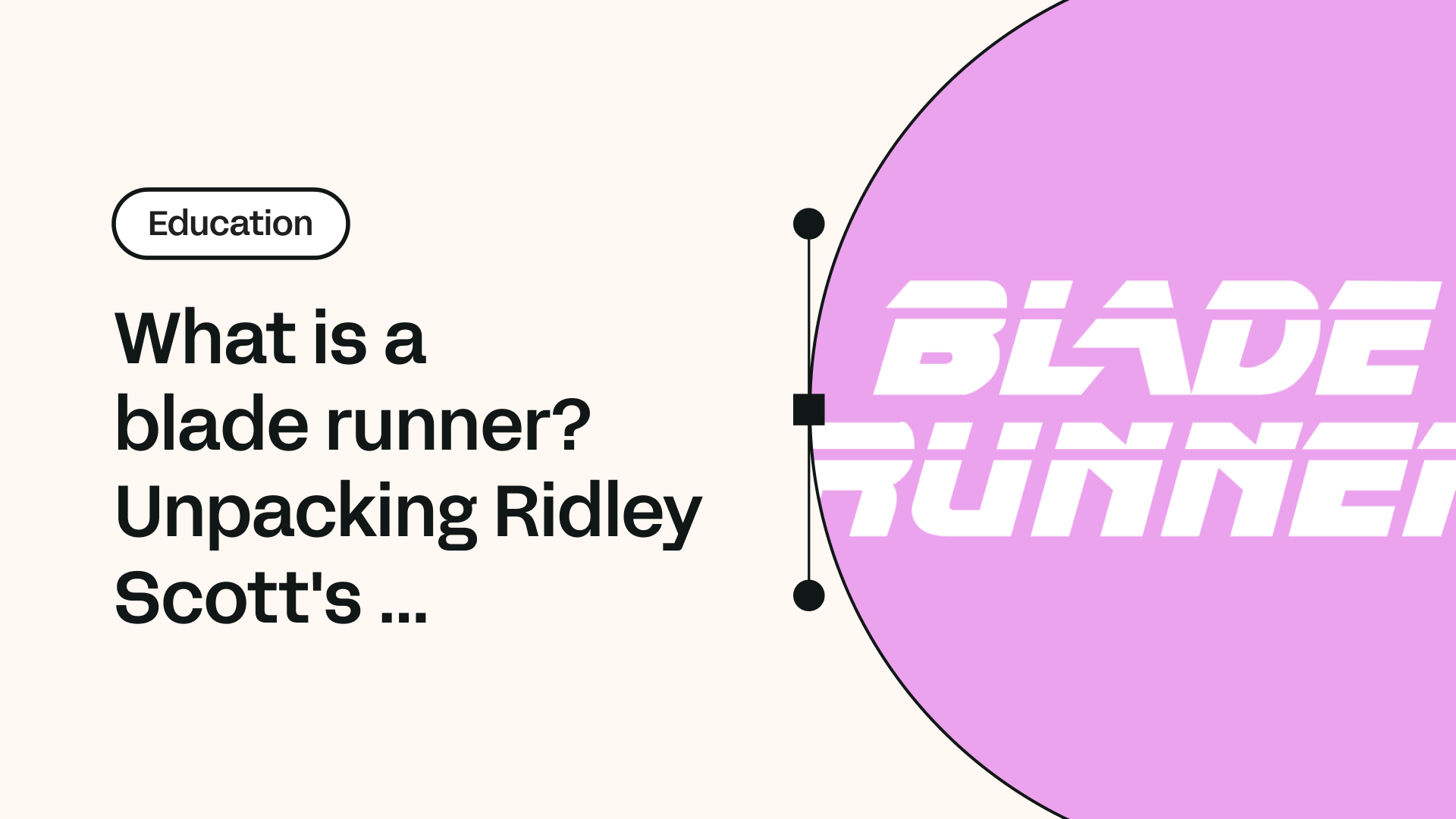
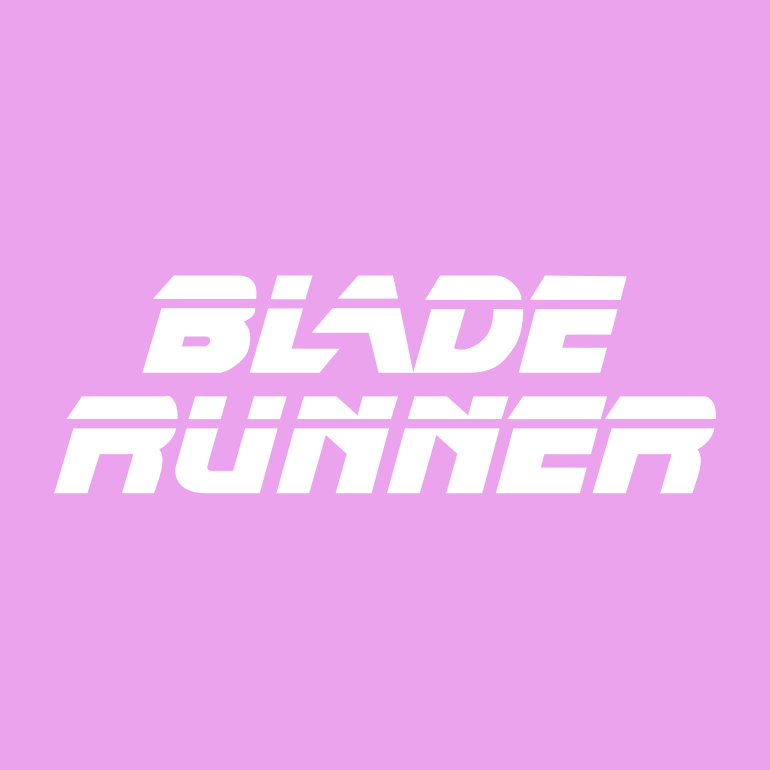
Share this!
Marion Gerlinger
Marion is a contributing writer to the Linearity Blog.
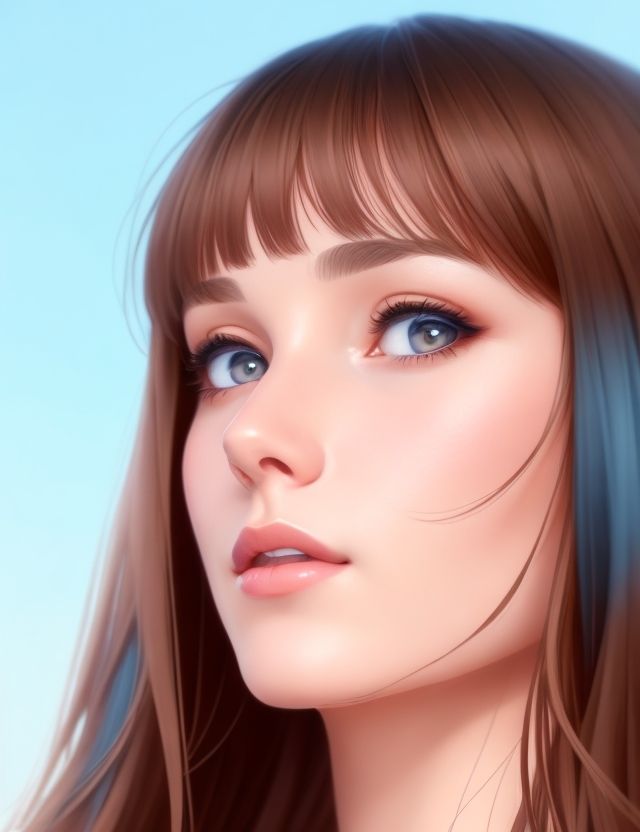

:quality(75))
:quality(75))



:quality(75))
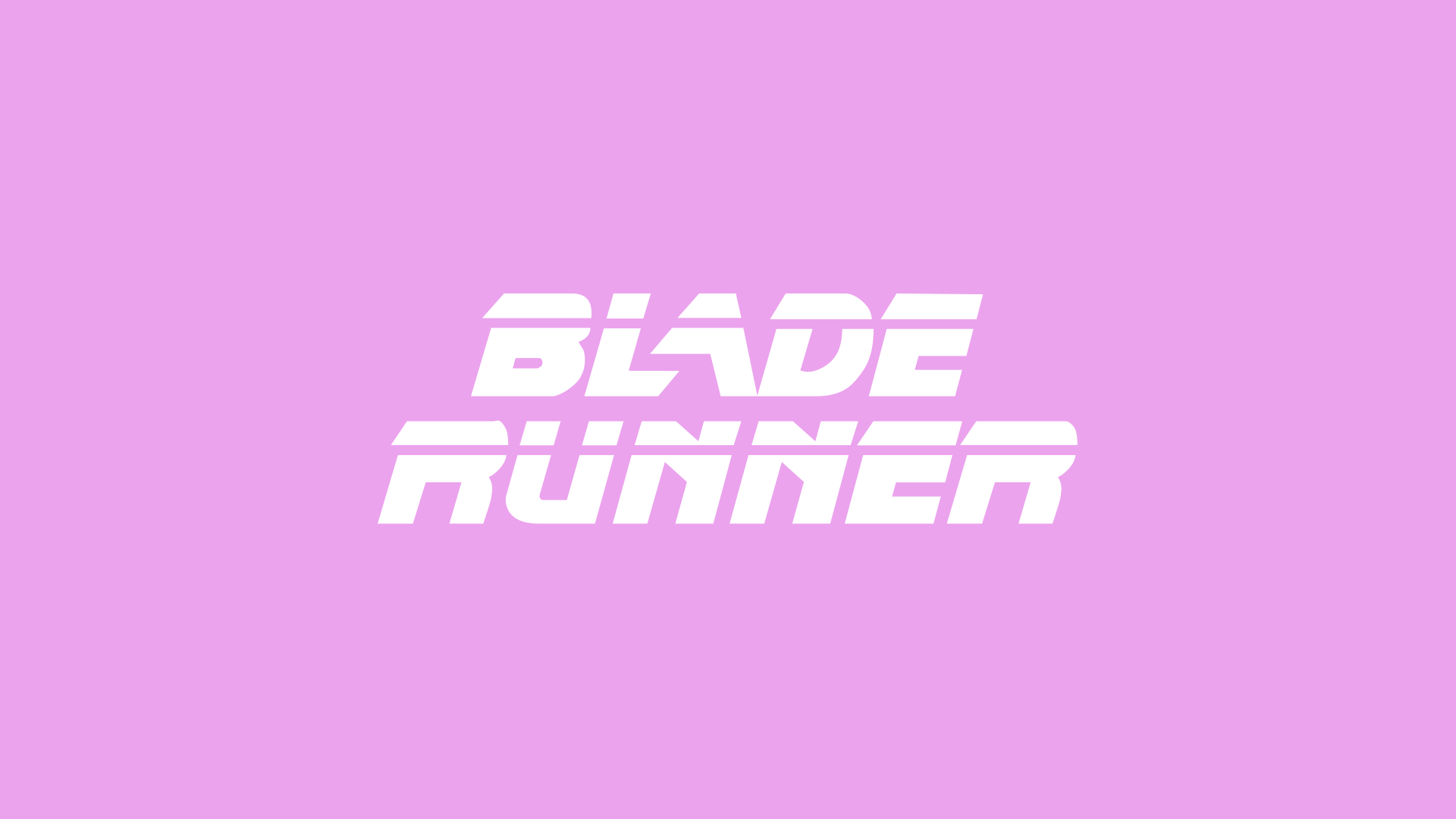
:quality(75))
:quality(75))
:quality(75))
:quality(75))


